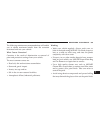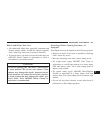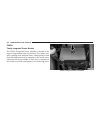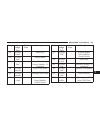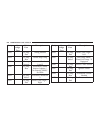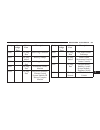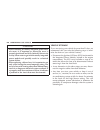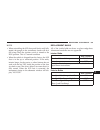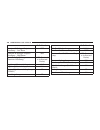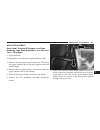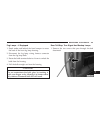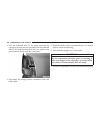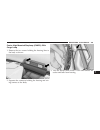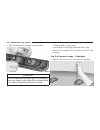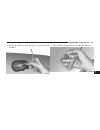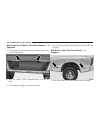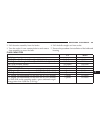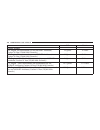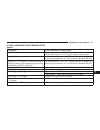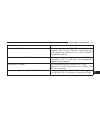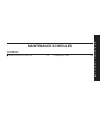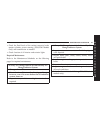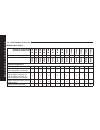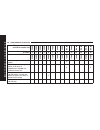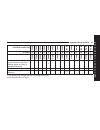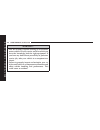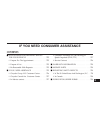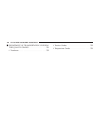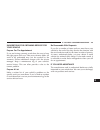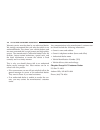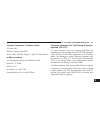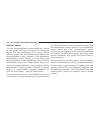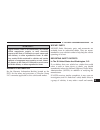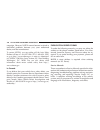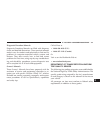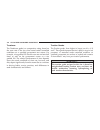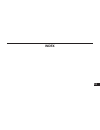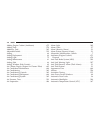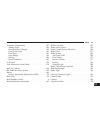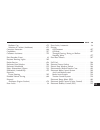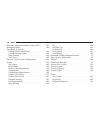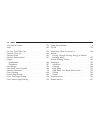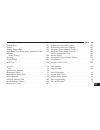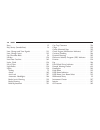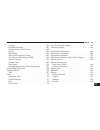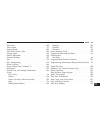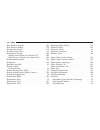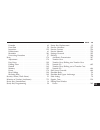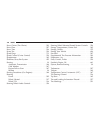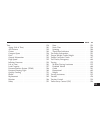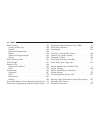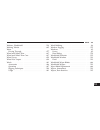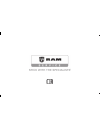- DL manuals
- RAM
- Trucks
- Trucks 1500
- Owner's Manual
RAM Trucks 1500 Owner's Manual
Summary of Trucks 1500
Page 1
1 5 0 0 / 2 5 0 0 / 3 5 0 0 chrysler group llc o w n e r ’ s m a n u a l 2 0 1 3 2 0 13 ram truck 1 500/2500/3500 13d241-126-ab first edition printed in u.S.A. R a m t r u c k.
Page 2
Vehicles sold in canada with respect to any vehicles sold in canada, the name chrysler group llc shall be deemed to be deleted and the name chrysler canada inc. Used in substitution therefore. Driving and alcohol drunken driving is one of the most frequent causes of acci- dents. Your driving ability...
Page 3: Table Of Contents
Table of contents section page 1 introduction . . . . . . . . . . . . . . . . . . . . . . . . . . . . . . . . . . . . . . . . . . . . . . . . . . . . . . . . . . . . . 3 2 things to know before starting your vehicle . . . . . . . . . . . . . . . . . . . . . . . . . . . . . 9 3 understanding the feat...
Page 5: Introduction
Introduction contents 䡵 introduction . . . . . . . . . . . . . . . . . . . . . . . .4 䡵 how to use this manual . . . . . . . . . . . . . .4 䡵 warnings and cautions . . . . . . . . . . . . . .6 䡵 van conversions/campers . . . . . . . . . . . .6 䡵 vehicle identification number . . . . . . . .6 䡵 vehic...
Page 6
Introduction congratulations on selecting your new chrysler group llc vehicle. Be assured that it represents precision workmanship, distinctive styling, and high quality - all essentials that are traditional to our vehicles. This owner’s manual has been prepared with the assis- tance of service and ...
Page 7
1 introduction 5.
Page 8
Warnings and cautions this owners manual contains warnings against oper- ating procedures that could result in a collision or bodily injury. It also contains cautions against procedures that could result in damage to your vehicle. If you do not read this entire owners manual, you may miss important ...
Page 9
Frame and underbody as well as the automobile infor- mation disclosure label affixed to a window on your vehicle, the vehicle registration and title. Note: it is illegal to remove or alter the vin. Vehicle modifications/alterations warning! Any modifications or alterations to this vehicle could seri...
Page 11: Contents
Things to know before starting your vehicle contents 䡵 a word about your keys . . . . . . . . . . . . .12 ▫ ignition system. . . . . . . . . . . . . . . . . . . . . . . .12 ▫ key fob . . . . . . . . . . . . . . . . . . . . . . . . . . . . .14 ▫ removing key fob from ignition . . . . . . . . . .16 ▫ ...
Page 12
▫ sound horn with remote key lock . . . . . . . . .26 ▫ using the panic alarm . . . . . . . . . . . . . . . . . .27 ▫ rke air suspension (remote lowering of the vehicle) — if equipped . . . . . . . . . . . . . . . . . .28 ▫ programming additional transmitters. . . . . . . .29 ▫ transmitter battery r...
Page 13
▫ seat belt pretensioners — if equipped . . . . . . .61 ▫ enhanced seat belt use reminder system (beltalert 威) . . . . . . . . . . . . . . . . . . . . . . . . . .62 ▫ seat belts and pregnant women . . . . . . . . . . .63 ▫ seat belt extender . . . . . . . . . . . . . . . . . . . . .63 ▫ supplemental...
Page 14
A word about your keys key fob with remote keyless entry (rke) — if equipped your vehicle uses a keyless ignition system. This system consists of a key fob with remote keyless entry (rke) transmitter and a wireless ignition node (win) with integral ignition switch. You can insert the key fob into th...
Page 15
Keyless ignition node (kin) — if equipped this feature allows the driver to operate the ignition switch with the push of a button, as long as the remote keyless entry (rke) transmitter is in the passenger compartment. The keyless ignition node (kin) has four operating positions, three of which are l...
Page 16
Put the nose side (side opposite of the emergency key) of the key fob against the engine start/stop button and push to operate the ignition switch. Key fob the key fob operates the ignition switch. Insert the square end of the key fob into the ignition switch located on the instrument panel and rota...
Page 17
Note: you can insert the double-sided emergency key into the lock cylinder with either side up. Emergency key removal (win) emergency key removal keyless enter-n-go™ fob (kin) 2 things to know before starting your vehicle 15.
Page 18
Removing key fob from ignition place the shift lever in park (if equipped with an automatic transmission). Turn the key fob to the off position and then remove the key fob. Note: • for vehicles not equipped with the electronic vehicle information center (evic), the power window switches, radio, powe...
Page 19
Warning! • before exiting a vehicle, always apply the parking brake, shift the transmission into park, and push ignition button to place ignition in off position. When leaving the vehicle, always lock your ve- hicle. • never leave children alone in a vehicle, or with access to an unlocked vehicle. •...
Page 20
Key-in-ignition reminder opening the driver’s door when the key fob is in the ignition and the ignition switch position is off or acc, a chime will sound to remind you to remove the key fob. Note: • the key-in-ignition reminder only sounds when the key fob is placed in the off or acc ignition positi...
Page 21
An invalid key fob to try to start the engine. Either of these conditions will result in the engine being shut off after two seconds. If the vehicle security light turns on during normal vehicle operation (vehicle running for longer than 10 sec- onds), it indicates that there is a fault in the elect...
Page 22
Duplication of key fobs may be performed at an autho- rized dealer, this procedure consists of programming a blank key fob to the vehicle electronics. A blank key fob is one that has never been programmed. Note: • when having the sentry key威 immobilizer system serviced, bring all vehicle keys with y...
Page 23
Vehicle security alarm — if equipped the vehicle security alarm monitors the vehicle doors and ignition for unauthorized operation. When the ve- hicle security alarm is activated, interior switches for door locks are disabled. The system provides both au- dible and visible signals, for the first thr...
Page 24
The vehicle security alarm will also disarm if a pro- grammed sentry key 威 is inserted into the ignition switch. To exit the alarming mode, press the rke trans- mitter unlock button, or insert a programmed sentry key 威 into the ignition switch. The vehicle security alarm is designed to protect your ...
Page 25
Note: • the front courtesy overhead console and door cour- tesy lights will not turn off if the dimmer control is in the “dome on” position (extreme top position). • the illuminated entry system will not operate if the dimmer control is in the “dome defeat” position (extreme bottom position). Remote...
Page 26
Remote unlock the doors press and release the unlock button on the rke transmitter once to unlock the driver’s door (if evic is setup for driver door first, otherwise this will unlock all doors), or press the unlock button twice within five seconds to unlock all doors, the tailgate and the rambox 威 ...
Page 27
Note: pressing the lock button on the rke transmit- ter while you are inside the vehicle will activate the vehicle security alarm system. Opening a door with the vehicle security alarm system activated will cause the alarm to sound. Press the unlock button to deactivate the vehicle security alarm sy...
Page 28
Note: pressing the lock button on the rke transmit- ter while you are in the vehicle will activate the vehicle security alarm system. Opening a door with the vehicle security alarm system activated will cause the alarm to sound. Press the unlock button to deactivate the vehicle security alarm system...
Page 29
2. Release both buttons at the same time. 3. Test the feature while outside of the vehicle by press- ing the lock button on the rke transmitter with the ignition switch in the off position and the key removed. 4. Repeat these steps if you want to return this feature to its previous setting. Note: pr...
Page 30
• you may need to be less than 35 ft (11 m) from the vehicle when using the rke transmitter to turn off the panic alarm due to the radio frequency noises emitted by the system. Rke air suspension (remote lowering of the vehicle) — if equipped for easy entry and loading, your vehicle can be lowered b...
Page 31
To cancel vehicle lowering, press the key fob air suspen- sion lowering button one time during the lowering pro- cess. When vehicle lowering is cancelled the horn will chirp two times and the hazard lights will flash four times. Once raising is completed, the horn will chirp one time. For further in...
Page 32
General information this device complies with part 15 of the fcc rules and rss 210 of industry canada. Operation is subject to the following conditions: • this device may not cause harmful interference. • this device must accept any interference received, including interference that may cause undesi...
Page 33
• hood closed • hazard switch off • brake switch inactive (brake pedal not pressed) • ignition key removed from ignition switch • battery at an acceptable charge level • rke panic button not pressed • fuel meets minimum requirement • system not disabled from previous remote start event • vehicle the...
Page 34
Remote start abort message on electronic vehicle information center (evic) — if equipped the following messages will display in the evic if the vehicle fails to remote start or exits remote start prema- turely: • remote start aborted — door ajar • remote start aborted — hood ajar • remote start abor...
Page 35
• for security, power window and power sunroof op- eration (if equipped) are disabled when the vehicle is in the remote start mode. • the engine can be started two consecutive times (two 15-minute cycles) with the rke transmitter. However, the ignition switch must be cycled to the on/run position be...
Page 36
• “remote start active — key to run” will display in the evic until you insert and turn the key to on/run position. Refer to “electronic vehicle information center (evic)” for further information. Remote start comfort systems — if equipped when remote start is activated, the heated steering wheel, a...
Page 37
Front doors may be opened with the inside door handle without lifting the lock knob. Doors locked before closing will remain locked when closed. The emergency key will unlock the driver door lock on your vehicle. Warning! • do not leave children or animals inside parked vehicles in hot weather. Inte...
Page 38
Power door locks — if equipped a power door lock switch is on each front door trim panel. Use this switch to lock or unlock the doors. If you press the power door lock switch while the key fob is in the ignition, and any front door is open, the power locks will not operate. This prevents you from ac...
Page 39
Auto unlock doors — if equipped this feature unlocks all of the doors of the vehicle when either front door is opened. This will occur only after the vehicle has been shifted into the park position after the vehicle has been driven (shifted out of park and all doors closed). Auto unlock doors progra...
Page 40
To use the system, open each rear door, use a flat blade screwdriver (or emergency key) and rotate the dial to engage and disengage the child-protection locks. When the system on a door is engaged, that door can only be opened by using the outside door handle even if the inside door lock is in the u...
Page 41
Keyless enter-n-go™ the passive entry system is an enhancement to the vehicle’s remote keyless entry (rke) system and a feature of keyless enter-n-go™. This feature allows you to lock and unlock the vehicle’s door(s) without having to press the rke transmitter lock or unlock buttons. Note: • passive...
Page 42
Note: if “unlock all doors 1st press” is programmed all doors will unlock when you grab hold of the front driver’s door handle. To select between “unlock driver door 1st press” and “unlock all doors 1st press”, refer to “uconnect touch™ settings” in “understanding your instrument panel” for further ...
Page 43
To lock the vehicle’s doors with one of the vehicle’s passive entry rke transmitters within 5 ft (1.5 m) of the driver or passenger front door handles, press the door handle lock button to lock all doors. Outside door handle lock button incorrect way to grab keyless enter-n-go™ door handle 2 things ...
Page 44
Note: • after pressing the door handle lock button, you must wait two seconds before you can lock or unlock the doors, using either passive entry door handle. This is done to allow you to check if the vehicle is locked by pulling the door handle, without the vehicle reacting and unlocking. • the pas...
Page 45
The control on the left front door panel has up-down switches that give you fingertip control of all power windows. There is a single opening and closing switch on the front passenger door for passenger window control and on the rear doors of the crew cab models. The windows will operate when the ig...
Page 46
Auto-down both the driver and front passenger window switch have an auto-down feature. Press the window switch past the first detent, release, and the window will go down automatically. To cancel the auto-down movement, op- erate the switch in either the up or down direction and release the switch. ...
Page 47
Reset auto-up should the auto up feature stop working, the window probably needs to be reset. To reset auto up: 1. Pull the window switch up to close the window completely and continue to hold the switch up for an additional two seconds after the window is closed. 2. Push the window switch down firm...
Page 48
Wind buffeting wind buffeting can be described as the perception of pressure on the ears or a helicopter-type sound in the ears. Your vehicle may exhibit wind buffeting with the windows down, or the sunroof (if equipped) in certain open or partially open positions. This is a normal occur- rence and ...
Page 49
• all seat belt systems (except driver’s and second row center position) include automatic locking retractors (alrs), which lock the seat belt webbing into position by extending the belt all the way out and then adjust- ing the belt to the desired length to restrain a child seat or secure a large it...
Page 50
Children that are not big enough to wear the vehicle seat belt properly (see section on child restraints) should be secured in the rear seat in child restraints or belt- positioning booster seats. Older children who do not use child restraints or belt-positioning booster seats should ride properly b...
Page 51
Warning! • relying on the air bags alone could lead to more severe injuries in a collision. The air bags work with your seat belt to restrain you properly. In some colli- sions, the air bags won’t deploy at all. Always wear your seat belts even though you have air bags. • being too close to the stee...
Page 52
Research has shown that seat belts save lives, and they can reduce the seriousness of injuries in a collision. Some of the worst injuries happen when people are thrown from the vehicle. Seat belts reduce the possibility of ejection and the risk of injury caused by striking the inside of the vehicle....
Page 53
Warning! (continued) of part of the belt. Follow these instructions to wear your seat belt safely and to keep your passengers safe, too. • two people should never be belted into a single seat belt. People belted together can crash into one another in a collision, hurting one another badly. Never use...
Page 54
3. When the belt is long enough to fit, insert the latch plate into the buckle until you hear a “click.” warning! • a belt buckled into the wrong buckle will not protect you properly. The lap portion could ride too high on your body, possibly causing internal inju- ries. Always buckle your belt into...
Page 55
Warning! (continued) • a shoulder belt placed behind you will not protect you from injury during a collision. You are more likely to hit your head in a collision if you do not wear your shoulder belt. The lap and shoulder belt are meant to be used together. 4. Position the lap belt across your thigh...
Page 56
Warning! • a lap belt worn too high can increase the risk of internal injury in a collision. The belt forces won’t be at the strong hip and pelvic bones, but across your abdomen. Always wear the lap belt as low as possible and keep it snug. • a twisted belt may not protect you properly. In a collisi...
Page 57
Regular cab front center three point belt 1. The front center seat belt on the regular cab may be disconnected to open up utilization of the storage areas behind the front seats. The black latch plate can be detached from the black keyed seat belt buckle located on the inboard side of the passenger ...
Page 58
2. To reattach the seat belt to the front center seat, pull the black buckle latch plate forward from the cab back panel and insert it into the black keyed buckle until there is an audible “click”. For proper seat belt usage, refer “lap/shoulder belt operating instructions”. Inserting latch plate in...
Page 59
Warning! • if the black latch and black buckle are not properly connected when the seat belt is used by an occu- pant, the seat belt will not be able to provide proper restraint and will increase the risk of injury in a collision. • when reattaching the black latch and black buckle, ensure the seat ...
Page 60
Adjustable upper shoulder belt anchorage in the front row outboard seats, the shoulder belt can be adjusted upward or downward to help position the belt away from your neck. Press the button located on the upper belt guide, and then move it up or down to the position that fits you best. As a guide, ...
Page 61
Warning! • a lap belt worn too loose or too high is dangerous. • a belt worn too loose can allow you to slip down and under the belt in a collision. • a belt that is too loose or too high will apply crash forces to the abdomen, not to the stronger hip bones. In either case, the risk of internal inju...
Page 62
If the passenger seating position is equipped with an alr and is being used for normal usage: only pull the belt webbing out far enough to comfortably wrap around the occupant’s mid-section so as to not activate the alr. If the alr is activated, you will hear a ratcheting sound as the belt retracts....
Page 63
How to disengage the automatic locking mode unbuckle the combination lap/shoulder belt and allow it to retract completely to disengage the automatic locking mode and activate the vehicle sensitive (emergency) locking mode. Warning! • the belt and retractor assembly must be replaced if the seat belt ...
Page 64
Note: these devices are not a substitute for proper seat belt placement by the occupant. The seat belt still must be worn snugly and positioned properly. The pretensioners are triggered by the occupant re- straint controller (orc). Like the air bags, the preten- sioners are single use items. A deplo...
Page 65
Beltalert 威 can be enabled or disabled by your authorized dealer. Chrysler group llc does not recommend deac- tivating beltalert 威. Note: although beltalert 威 has been deactivated, the seat belt reminder light will continue to illuminate while the driver’s or front passenger (if equipped with beltal...
Page 66
Supplemental restraint system (srs) — air bags this vehicle has advanced front air bags for both the driver and front passenger as a supplement to the seat belt restraint systems. The driver’s advanced front air bag is mounted in the center of the steering wheel. The passenger’s advanced front air b...
Page 67
Note: the driver and front passenger advanced front air bags are certified to the new federal regulations for advanced air bags. The advanced front air bags have a multistage inflator design. This allows the air bag to have different rates of inflation based on several factors, including the severit...
Page 68
Air bag system components your vehicle may be equipped with the following air bag system components: • occupant restraint controller (orc) • air bag warning light • steering wheel and column • instrument panel • knee impact bolster • driver advanced front air bag • passenger advanced front air bag •...
Page 69
Advanced front air bag features the advanced front air bag system has multistage driver and front passenger air bags. This system provides output appropriate to the severity and type of collision as determined by the occupant restraint controller (orc), which may receive information from the front i...
Page 70
Supplemental seat-mounted side air bags (sab) — if equipped supplemental seat-mounted side air bags may provide enhanced protection to help protect an occupant during a side impact. The supplemental seat-mounted side air bag is marked with an air bag label sewn into the outboard side of the front se...
Page 71
Supplemental side air bag inflatable curtain (sabic) — if equipped sabic air bags may offer side-impact protection to front and rear seat outboard occupants in addition to that provided by the body structure. Each air bag features inflated chambers placed adjacent to the head of each outboard occupa...
Page 72
Note: • air bag covers may not be obvious in the interior trim, but they will open during air bag deployment. • being too close to the sab and sabic air bags during deployment could cause you to be severely injured or killed. The system includes side impact sensors that are cali- brated to deploy th...
Page 73
Windows, or area where the sab or sabic air bags inflate, even if they are in an infant or child restraint. Always sit upright as possible with your back against the seat back, use the seat belts properly, and use the appro- priate sized child restraint, infant restraint or booster seat recommended ...
Page 74
The advanced front air bags will not deploy in all frontal collisions, including some that may produce sub- stantial vehicle damage — for example, some pole colli- sions, truck underrides, and angle offset collisions. On the other hand, depending on the type and location of impact, advanced front ai...
Page 75
It also includes diagnostics that will illuminate the instru- ment cluster air bag warning light if a malfunction is noted that could affect the air bag system. The diagnos- tics also record the nature of the malfunction. Warning! Ignoring the air bag warning light in your instru- ment panel could m...
Page 76
Supplemental seat-mounted side air bag (sab) inflator units — if equipped the supplemental seat-mounted side air bags are de- signed to activate only in certain side collisions. The orc determines if a side collision requires the side air bags to inflate, based on the severity and type of collision....
Page 77
Because air bag sensors estimate deceleration over time, vehicle speed and damage are not good indicators of whether or not an air bag should have deployed. Front and side impact sensors in front and side impacts, impact sensors can aid the orc in determining appropriate response to impact events. E...
Page 78
2. The led light located between the assist and 9-1-1 buttons on the rearview mirror will turn green once a connection to a 9-1-1 operator has been made; 3. Once a connection between the vehicle and a 9-1-1 operator is made, the 9-1-1 call system may transmit the following important vehicle informat...
Page 79
Warning! • if anyone in the vehicle could be in danger (e.G., fire or smoke is visible, dangerous road conditions or location), do not wait for voice contact from a 9-1-1 operator. All occupants should exit the vehicle immediately and move to a safe location. • the 9-1-1 call system is embedded into...
Page 80
If the 9-1-1 call system detects a malfunction, any of the following may occur at the time the malfunction is detected, and at the beginning of each ignition cycle: • the rearview mirror light located between the assist and 9-1-1 buttons will continuously be illuminated red; • the phone screen will ...
Page 81
Even if the 9-1-1 call system is fully functional, factors beyond chrysler group llc’s control may prevent or stop the 9-1-1 call system operation. These include, but are not limited to, the following factors: • the ignition key has been removed from the ignition and the delayed accessories mode is ...
Page 82
General information this device complies with part 15 of the fcc rules. Operation is subject to the following two conditions: (1) this device may not cause harmful interference, and (2) this device must accept any interference received, including interference that may cause undesired opera- tion. If...
Page 83
Skin, eyes, nose, or throat. If you have skin or eye irritation, rinse the area with cool water. For nose or throat irritation, move to fresh air. If the irritation continues, see your doctor. If these particles settle on your clothing, follow the garment manufacturer’s in- structions for cleaning. ...
Page 84
Warning! (continued) • do not attempt to modify any part of your air bag system. The air bag may inflate accidentally or may not function properly if modifications are made. Take your vehicle to an authorized dealer for any air bag system service. If your seat, including your trim cover and cushion,...
Page 85
Note: if the speedometer, tachometer, or any engine related gauges are not working, the occupant restraint controller (orc) may also be disabled. The air bags may not be ready to inflate for your protection. Promptly check the fuse block for blown fuses. Refer to the label located on the inside of t...
Page 86
Note: edr data are recorded by your vehicle only if a non-trivial crash situation occurs; no data are recorded by the edr under normal driving conditions and no per- sonal data (e.G., name, gender, age, and crash location) are recorded. However, other parties, such as law en- forcement, could combin...
Page 87
Before buying any restraint system, make sure that it has a label certifying that it meets all applicable safety standards. You should also make sure that you can install it in the vehicle where you will use it. Note: for additional information, refer to www.Seatcheck.Org or call 1–866–seatcheck. Ca...
Page 88
Summary of recommendations for restraining children in vehicles child size, height, weight or age recommended type of child restraint infants and toddlers children who are two years old or younger and who have not reached the height or weight limits of their child restraint either an infant carrier ...
Page 89
Infants and child restraints safety experts recommend that children ride rearward- facing in the vehicle until they are two years old or until they reach either the height or weight limit of their rear facing child safety seat. Two types of child restraints can be used rearward-facing: infant carrie...
Page 90
Older children and child restraints children who are two years old or who have outgrown their rear-facing convertible child seat can ride forward- facing in the vehicle. Forward-facing child seats and convertible child seats used in the forward-facing direc- tion are for children who are over two ye...
Page 91
Children too large for booster seats children who are large enough to wear the shoulder belt comfortably, and whose legs are long enough to bend over the front of the seat when their back is against the seatback, should use the seat belt in a rear seat. Use this simple 5-step test to decide whether ...
Page 92
Recommendations for attaching child restraints — quad cab 威/crew cab restraint type combined weight of the child + child restraint use any attachment method shown with an “x” below latch – lower anchors only seat belt only latch – lower anchors + top tether anchor seat belt + top tether anchor rear-...
Page 93
Recommendations for attaching child restraints — standard cab, mega cab 威 restraint type combined weight of the child + child restraint use any attachment method shown with an “x” below latch – lower anchors only seat belt only latch – lower anchors + top tether anchor seat belt + top tether anchor ...
Page 94
Lower anchors and tethers for children (latch) restraint system your vehicle is equipped with the child restraint anchor- age system called latch, which stands for lower anchors and tethers for children. The latch system has three vehicle anchor points for installing latch- equipped child seats. The...
Page 95
Latch positions for installing child restraints in this vehicle standard cab lower anchorage symbol 2 anchorages per seating position top tether anchorage symbol quad cab 威/crew cab full bench lower anchorage symbol 2 anchorages per seating position top tether anchorage symbol 2 things to know befor...
Page 96
Quad cab 威/mega cab威/crew cab split bench lower anchorage symbol 2 anchorages per seating position top tether anchorage symbol 94 things to know before starting your vehicle.
Page 97
Quad cab 威/crew cab what is the weight limit (child’s weight + weight of the child restraint) for using the latch anchorage system to attach the child restraint? 65 lbs (29.5 kg) use the latch anchorage system until the combined weight of the child and the child restraint is 65 lbs (29.5 kg). Use th...
Page 98
Can two child restraints be attached using a common lower latch anchorage? No never “share” a latch anchorage with two or more child restraints. If the center position does not have dedicated latch lower anchorages, use the seat belt to install a child seat in the center position next to a child sea...
Page 99
Mega cab 威/standard cab what is the weight limit (child’s weight + weight of the child restraint) for using the latch anchorage system to attach the child restraint? 65 lbs (29.5 kg) use the latch anchorage system until the combined weight of the child and the child restraint is 65 lbs (29.5 kg). Us...
Page 100
Can two child restraints be attached using a common lower latch anchorage? No never “share” a latch anchorage with two or more child restraints. If the center position does not have dedicated latch lower anchorages, use the seat belt to install a child seat in the center position next to a child sea...
Page 101
Locating the latch anchorages — quad cab 威/mega cab威/crew cab the lower anchorages are round bars that are found at the rear of the seat cushion where it meets the seatback. They are just visible when you lean into the rear seat to install the child restraint. You will easily feel them if you run yo...
Page 102
Locating the latch anchorages in addition, regular cab models have tether strap an- chorages behind the front center and right seats. Quad cab 威, mega cab威 and crew cab models have tether strap anchorages located behind each of the rear seats. 1 — tether strap hook 2 — tether strap to child restrain...
Page 103
Latch-compatible child restraint systems will be equipped with a rigid bar or a flexible strap on each side. Each will have a hook or connector to attach to the lower anchorage and a way to tighten the connection to the anchorage. Forward-facing child restraints and some rear-facing infant restraint...
Page 104
Center seat latch — quad cab 威/mega cab 威/crew cab split bench if a child restraint installed in the center position blocks the seat belt webbing or buckle for the outboard position, do not use that outboard position. If a child seat in the center position blocks the outboard latch anchors or seat b...
Page 105
4. Attach the lower hooks or connectors of the child restraint to the lower anchorages in the selected seat- ing position. 5. If the child restraint has a tether strap, connect it to the top tether anchorage. See the section “installing child restraints using the top tether anchorage” for direc- tio...
Page 106
Warning! Improper installation of a child restraint to the latch anchorages can lead to failure of the re- straint. The child could be badly injured or killed. Follow the child restraint manufacturer’s directions exactly when installing an infant or child restraint. Installing child restraints using...
Page 107
Lap/shoulder belt systems for installing child restraints in this vehicle standard cab quad cab 威/mega cab威/crew cab 2 things to know before starting your vehicle 105.
Page 108
Quad cab 威/crew cab what is the weight limit (child’s weight + weight of the child restraint) for using the tether anchor with the seat belt to attach a forward facing child restraint? Weight limit of the child restraint always use the tether anchor when using the seat belt to install a forward faci...
Page 109
Mega cab 威/standard cab what is the weight limit (child’s weight + weight of the child restraint) for using the tether anchor with the seat belt to attach a forward facing child restraint? 65 lbs (29.5 kg) the tether anchor can be used with the seat belt until the combined weight of the child and th...
Page 110
Installing a child restraint with a switchable automatic locking retractor (alr) 1. Place the child seat in the center of the seating position. For some second row seats, you may need to recline the seat and/or raise the head restraint to get a better fit. 2. Pull enough of the seat belt webbing fro...
Page 111
8. If the child restraint has a top tether strap and the seating position has a top tether anchorage, connect the tether strap to the anchorage and tighten the tether strap. Refer to “lower anchors and tethers for chil- dren (latch) restraint system” for directions to attach a tether anchor. 9. Test...
Page 112
5. If the child restraint has a top tether strap and the seating position has a top tether anchorage, connect the tether strap to the anchorage and tighten the tether strap. Refer to “lower anchors and tethers for chil- dren (latch) restraint system” for directions to attach a tether anchor. 6. Test...
Page 113
Installing child restraints using the top tether anchorage regular and mega cab 威 trucks: in the regular cab truck, the top tether anchorages are located behind the center and right passenger seats. In the mega cab truck, the top tether anchorages are located behind each rear seating position. There...
Page 114
2. Route the tether strap to provide the most direct path between the anchorage and the child seat. The tether strap should go between the head restraint posts underneath the head restraint. You may need to adjust the head restraint to the upward position to pass the tether strap underneath the head...
Page 115
Warning! Never place a rear facing infant seat in front of an air bag. A deploying passenger advanced front air bag can cause death or serious injury to a child 12 years or younger, including a child in a rearward facing infant seat. Quad cab 威 or crew cab trucks: the top tether anchor- ages in this...
Page 116
2. Place a child restraint on the seat and adjust the tether strap so that it will reach over the seat back, under the head restraint, through the tether strap loop behind the seat and over to the tether strap loop behind the center seat. 3. Pass the tether strap hook under the head restraint behind...
Page 117
4. Attach the hook to the center tether strap loop (see diagram). Tighten the tether strap according to the child seat manufacturer’s instructions. Note: if there are child seats in both of the outboard (left and right) seating positions, the tether strap hooks of both child seats should be connecte...
Page 118
Center seat: 1. Raise the head restraint and reach between the rear seat and rear glass to access the tether strap loop. 2. Place a child restraint on the seat and adjust the tether strap so that it will reach over the seat back, under the head restraint, through the tether strap loop behind the sea...
Page 119
4. Attach the hook to the outboard tether strap loop (see diagram). Tighten the tether strap according to the child seat manufacturer’s instructions. Tether strap through center tether strap loop tether strap through center tether strap loop and attached to outboard tether strap loop 2 things to kno...
Page 120
Installing three child restraints: 1. Place a child restraint on each outboard rear seat. Route the tether straps following the directions for right and left seating positions, above. 2. Attach both hooks to the center tether strap loop, but do not tighten the straps yet. 3. Place a child restraint ...
Page 121
Warning! • an incorrectly anchored tether strap could lead to increased head motion and possible injury to the child. Use only the anchorage position directly behind the child seat to secure a child restraint top tether strap. • if your vehicle is equipped with a split rear seat, make sure the tethe...
Page 122
Caution! Never use non-detergent oil or straight mineral oil in the engine or damage may result. Note: a new engine may consume some oil during its first few thousand miles (kilometers) of operation. This should be considered a normal part of the break-in and not interpreted as an indication of diff...
Page 123
Exhaust gas warning! Exhaust gases can injure or kill. They contain carbon monoxide (co), which is colorless and odorless. Breathing it can make you unconscious and can eventually poison you. To avoid breathing (co), follow these safety tips: • do not run the engine in a closed garage or in confined...
Page 124
Safety checks you should make inside the vehicle seat belts inspect the belt system periodically, checking for cuts, frays, and loose parts. Damaged parts must be replaced immediately. Do not disassemble or modify the system. Front seat belt assemblies must be replaced after a collision. Rear seat b...
Page 125
Warning! Pedals that cannot move freely can cause loss of vehicle control and increase the risk of serious per- sonal injury. • always make sure that floor mats are properly attached to the floor mat fasteners. • never place or install floor mats or other floor coverings in the vehicle that cannot b...
Page 126
Periodic safety checks you should make outside the vehicle tires examine tires for excessive tread wear and uneven wear patterns. Check for stones, nails, glass, or other objects lodged in the tread or sidewall. Inspect the tread for cuts and cracks. Inspect sidewalls for cuts, cracks and bulges. Ch...
Page 127: Contents
Understanding the features of your vehicle contents 䡵 mirrors . . . . . . . . . . . . . . . . . . . . . . . . . . . .132 ▫ inside day/night mirror . . . . . . . . . . . . . . . .132 ▫ automatic dimming mirror — if equipped . . .133 ▫ automatic dimming mirror with rear view camera display — if equipp...
Page 128
▫ advanced phone connectivity . . . . . . . . . . . .159 ▫ things you should know about your uconnect™ phone . . . . . . . . . . . . . . . . . . . . .160 ▫ general information . . . . . . . . . . . . . . . . . . .172 䡵 voice command — if equipped . . . . . . .172 ▫ voice command system operation . ....
Page 129
䡵 lights . . . . . . . . . . . . . . . . . . . . . . . . . . . . .202 ▫ headlights . . . . . . . . . . . . . . . . . . . . . . . . . .203 ▫ automatic headlights — if equipped . . . . . . .204 ▫ headlights on with wipers (available with automatic headlights only) . . . . . . . . . . . . . .204 ▫ dayt...
Page 130
䡵 heated steering wheel — if equipped . .217 䡵 driver adjustable pedals — if equipped . . . . . . . . . . . . . . . . . . . . . . . . . . .219 䡵 electronic speed control . . . . . . . . . . .220 ▫ to activate . . . . . . . . . . . . . . . . . . . . . . . . . .221 ▫ to set a desired speed . . . . . ....
Page 131
䡵 garage door opener — if equipped. . . .238 ▫ before you begin programming homelink威. . .239 ▫ programming a rolling code . . . . . . . . . . . . .239 ▫ programming a non-rolling code . . . . . . . . .242 ▫ canadian/gate operator programming . . . . . .243 ▫ using homelink威 . . . . . . . . . . . . ...
Page 132
䡵 cupholders . . . . . . . . . . . . . . . . . . . . . . . .257 ▫ front instrument panel cupholders — (40–20–40 seats). . . . . . . . . . . . . . . . . . . . . . .257 ▫ front instrument panel cupholders — floor mounted shifter . . . . . . . . . . . . . . . . . . . . . .258 ▫ rear cupholder — quad ca...
Page 133
▫ bed extender — if equipped . . . . . . . . . . . . .280 ▫ bed rail tie-down system . . . . . . . . . . . . . .287 䡵 slide-in campers . . . . . . . . . . . . . . . . . . . .289 ▫ camper applications . . . . . . . . . . . . . . . . . . .289 䡵 easy-off tailgate . . . . . . . . . . . . . . . . . . .28...
Page 134
Mirrors inside day/night mirror a single ball joint mirror is provided in the vehicle. It is a twist on mirror that has a fixed position at the wind- shield. The mirror installs on the windshield button with a counterclockwise rotation and requires no tools for mounting. The mirror head can be adjus...
Page 135
Automatic dimming mirror — if equipped a single ball joint mirror is provided in the vehicle. It is a twist on mirror that has a fixed position at the wind- shield. The mirror installs on the windshield button with a counterclockwise rotation and requires no tools for mounting. The mirror head can b...
Page 136
Automatic dimming mirror with rear view camera display — if equipped a single ball joint mirror is provided in the vehicle. It is a twist on mirror that has a fixed position at the wind- shield. The mirror installs on the windshield button with a counterclockwise rotation and requires no tools for m...
Page 137
Warning! Vehicles and other objects seen in the passenger side convex mirror will look smaller and farther away than they really are. Relying too much on your passenger side convex mirror could cause you to collide with another vehicle or other object. Use your inside mirror when judging the size or...
Page 138
Power mirrors — if equipped the controls for the power mirrors are located on the driver’s door trim panel. The power mirror controls consist of mirror select but- tons and a four-way mirror control switch. Power mirror controls location power mirror controls 1 — mirror select buttons 2 — four-way m...
Page 139
To adjust a mirror, press either the l (left) or r (right) button to select the mirror that you want to adjust. Using the mirror control switch, press on any of the four arrows for the direction that you want the mirror to move heated mirrors — if equipped these mirrors are heated to melt frost or i...
Page 140
Illuminated vanity mirror — if equipped illuminated vanity mirrors are located on each sun visor. To use the mirror, rotate the sun visor down and swing the mirror cover upward. The lights will turn on auto- matically. Closing the mirror cover turns off the light. “slide-on-rod” features of sun viso...
Page 141
Trailer towing mirrors — if equipped these mirrors are designed with an adjustable mirror head to provide a greater vision range when towing extra-wide loads. To change position inboard or outboard, the mirror head should be rotated (flipped in or out). “slide-on-rod” extender trailer towing positio...
Page 142
Note: fold the trailer towing mirrors rearward prior to entering an automated car wash. A small blindspot mirror is located next to main mirror and can be adjusted separately. Uconnect™ phone — if equipped uconnect™ phone is a voice-activated, hands-free, in- vehicle communications system. Uconnect™...
Page 143
Uconnect™ phone allows you to transfer calls between the system and your mobile phone as you enter or exit your vehicle and enables you to mute the system’s microphone for private conversation. The uconnect™ phone is driven through your bluetooth 威 “hands-free profile” mobile phone. Uconnect™ featur...
Page 144
Voice command button actual button location may vary with the ra- dio. The individual buttons are described in the “operation” section. The uconnect™ phone can be used with any hands-free profile certified bluetooth 威 mobile phone. See the uconnect™ website for supported phones. Refer to your mobile...
Page 145
• for each feature explanation in this section, only the compound form of the voice command is given. You can also break the commands into parts and say each part of the command when you are asked for it. For example, you can use the compound form voice com- mand “phonebook new entry”, or you can br...
Page 146
The following are general phone to uconnect™ phone pairing instructions: • press the button to begin. • after the “ready” prompt and the following beep, say “device pairing”. • when prompted, after the beep, say “pair a device” and follow the audible prompts. • you will be asked to say a four-digit ...
Page 147
Dial by saying a number • press the button to begin. • after the “ready” prompt and the following beep, say “dial”. • the system will prompt you to say the number you want to call. • for example, you can say “234-567-8901”. • the uconnect™ phone will confirm the phone number and then dial. The numbe...
Page 148
Add names to your uconnect™ phonebook note: adding names to the uconnect™ phonebook is recommended when the vehicle is not in motion. • press the button to begin. • after the “ready” prompt and the following beep, say “phonebook new entry”. • when prompted, say the name of the new entry. Use of long...
Page 149
Phonebook download – automatic phonebook transfer from mobile phone if equipped and specifically supported by your phone, uconnect™ phone automatically downloads names (text names) and number entries from your mobile phone’s phonebook. Specific bluetooth 威 phones with phone book access profile may s...
Page 150
Edit uconnect™ phonebook entries note: • editing names in the phonebook is recommended when the vehicle is not in motion. • automatic downloaded phonebook entries cannot be deleted or edited. • press the button to begin. • after the “ready” prompt and the following beep, say “phonebook edit entry”. ...
Page 151
• after you enter the phonebook delete menu, you will then be asked for the name of the entry that you wish to delete. You can either say the name of a phonebook entry that you wish to delete or you can say “list names” to hear a list of the entries in the phonebook from which you choose. To select ...
Page 152
List all names in the uconnect™ phonebook • press the button to begin. • after the “ready” prompt and the following beep, say “phonebook list names”. • the uconnect™ phone will play the names of all the phonebook entries, including the downloaded phone- book entries, if available. • to call one of t...
Page 153
Answer or reject an incoming call — call currently in progress if a call is currently in progress and you have another incoming call, you will hear the same network tones for call waiting that you normally hear when using your mobile phone. Press the button to place the current call on hold and answ...
Page 154
Conference call when two calls are in progress (one active and one on hold), press and hold the button until you hear a double beep indicating that the two calls have been joined into one conference call. Three-way calling to initiate three-way calling, press the button while a call is in progress, ...
Page 155
Call continuation call continuation is the progression of a phone call on the uconnect™ phone after the vehicle ignition key has been switched to off. Call continuation functionality avail- able on the vehicle can be any one of three types: • after the ignition key is switched to off, a call can con...
Page 156
Emergency assistance if you are in an emergency and the mobile phone is reachable: • pick up the phone and manually dial the emergency number for your area. If the phone is not reachable and the uconnect™ phone is operational, you may reach the emergency number as follows: • press the button to begi...
Page 157
Warning! To use your uconnect™ phone system in an emer- gency, your mobile phone must be: • turned on, • paired to the uconnect™ system, • and have network coverage. Roadside assistance if you need roadside assistance: • press the button to begin. • after the “ready” prompt and the following beep, s...
Page 158
Voice mail calling to learn how to access your voice mail, refer to “working with automated systems”. Working with automated systems this method is used in instances where one generally has to press numbers on the mobile phone keypad while navigating through an automated telephone system. You can us...
Page 159
Note: • you may not hear all of the tones due to mobile phone network configurations. This is normal. • some paging and voice mail systems have system time out settings that are too short and may not allow the use of this feature. Barge in — overriding prompts the “voice command” button can be used ...
Page 160
Dialing using the mobile phone keypad you can dial a phone number with your mobile phone keypad and still use the uconnect™ phone (while dialing via the mobile phone keypad, the user must exercise caution and take precautionary safety measures). By dialing a number with your paired bluetooth 威 mobil...
Page 161
Advanced phone connectivity transfer call to and from mobile phone the uconnect™ phone allows ongoing calls to be trans- ferred from your mobile phone to the uconnect™ phone without terminating the call. To transfer an ongoing call from your uconnect™ phone paired mobile phone to the uconnect™ phone...
Page 162
Select another mobile phone this feature allows you to select and start using another phone paired with the uconnect™ phone. • press the button to begin. • after the “ready” prompt and the following beep, say “setup select phone” and follow the prompts. • you can also press the button at any time wh...
Page 163
Voice training for users experiencing difficulty with the system recogniz- ing their voice commands or numbers, the uconnect™ phone voice training feature may be used. To enter this training mode, follow one of the two following procedures: from outside the uconnect™ phone mode (e.G., from radio mod...
Page 164
Voice command • for best performance, adjust the rearview mirror to provide at least ½ in (1 cm) gap between the overhead console (if equipped) and the mirror. • always wait for the beep before speaking. • speak normally, without pausing, just as you would speak to a person sitting a few feet/meters...
Page 165
• even though international dialing for most number combinations is supported, some shortcut dialing number combinations may not be supported. • in a convertible vehicle, system performance may be compromised with the convertible top down. Far end audio performance • audio quality is maximized under...
Page 166
Read messages: if you receive a new text message while your phone is connected to uconnect™ phone, an announcement will be made to notify you that you have a new text message. If you wish to hear the new message: • press the button. • after the “ready” prompt and the following beep, say “sms read” o...
Page 167
List of preset messages: 1. Yes 2. No 3. Where are you? 4. I need more direction. 5. L o l 6. Why 7. I love you 8. Call me 9. Call me later 10. Thanks 11. See you in 15 minutes 12. I am on my way 13. I’ll be late 14. Are you there yet? 15. Where are we meeting? 16. Can this wait? 17. Bye for now 18....
Page 168
Turn sms incoming announcement on/off turning the sms incoming announcement off will stop the system from announcing the new incoming messages. • press the button. • after the “ready” prompt and the following beep, say “setup, sms incoming message announcement,” you will then be given a choice to ch...
Page 169
3 understanding the features of your vehicle 167.
Page 170
168 understanding the features of your vehicle.
Page 171
3 understanding the features of your vehicle 169.
Page 172
Voice commands primary alternate (s) zero one two three four five six seven eight nine star (*) plus (+) pound (#) add location all call cancel confirmation prompts continue delete dial download edit emergency english erase all espanol francais help home 170 understanding the features of your vehicl...
Page 173
Language list names list phones mobile mute mute off new entry no other pair a phone phone pairing pairing phonebook phone book previous record again redial return to main menu return or main menu select phone select send set up phone settings or phone set up towing assistance transfer call uconnect...
Page 174
General information this device complies with part 15 of the fcc rules and rss 210 of industry canada. Operation is subject to the following conditions: • changes or modifications not expressly approved by the party responsible for compliance could void the user’s authority to operate the equipment....
Page 175
Warning! Any voice commanded system should be used only in safe driving conditions following all applicable laws. All attention should be kept on the roadway ahead. Failure to do so may result in a collision causing serious injury or death. When you press the voice command button, you will hear a be...
Page 176
At any point, if the system does not recognize one of your commands, you will be prompted to repeat it. To hear the first available menu, press the voice com- mand button and say “help” or “main menu”. Commands the voice command system understands two types of commands. Universal commands are availa...
Page 177
Radio am (or radio long wave or radio medium wave — if equipped) to switch to the am band, say “am” or “radio am”. In this mode, you may say the following commands: • “frequency #” (to change the frequency) • “next station” (to select the next station) • “previous station” (to select the previous st...
Page 178
Disc to switch to the disc mode, say “disc”. In this mode, you may say the following commands: • “track” (#) (to change the track) • “next track” (to play the next track) • “previous track” (to play the previous track) • “main menu” (to switch to the main menu) memo to switch to the voice recorder m...
Page 179
• “switch to system setup” • “change to setup” • “main menu setup” or • “switch to setup” in this mode, you may say the following commands: • “language english” • “language french” • “language spanish” • “tutorial” • “voice training” note: keep in mind that you have to press the voice command button...
Page 180
Seats seats are a part of the occupant restraint system of the vehicle. Warning! • it is dangerous to ride in a cargo area, inside or outside of a vehicle. In a collision, people riding in these areas are more likely to be seriously injured or killed. • do not allow people to ride in any area of you...
Page 181
Adjusting the seat forward or rearward the seat can be adjusted both forward and rearward. Push the seat switch forward or rearward, the seat will move in the direction of the switch. Release the switch when the desired position has been reached. Adjusting the seat up or down the height of the seats...
Page 182
Reclining the seatback the angle of the seatback can be adjusted forward or rearward. Push the seatback switch forward or rearward, the seat will move in the direction of the switch. Release the switch when the desired position is reached. Warning! • adjusting a seat while driving may be dangerous. ...
Page 183
Adjusting the seat forward or rearward the seat can be adjusted both forward and rearward. Push the seat switch forward or rearward, the seat will move in the direction of the switch. Release the switch when the desired position has been reached. Adjusting the seat up or down the height of the seats...
Page 184
Caution! Do not place any article under a power seat or impede its ability to move as it may cause damage to the seat controls. Seat travel may become limited if movement is stopped by an obstruction in the seat’s path. Power lumbar — if equipped vehicles equipped with power driver or passenger seat...
Page 185
Heated seats — if equipped on some models, the front and rear seats may be equipped with heaters in both the seat cushions and seatbacks. Warning! • persons who are unable to feel pain to the skin because of advanced age, chronic illness, diabetes, spinal cord injury, medication, exhaustion or other...
Page 186
Note: • once a heat setting is selected, heat will be felt within two to five minutes. • the engine must be running for the heated seats to operate. The heated seats switch from high to low and from low to off automatically, based on time and tempera- ture of the seat. The heated seats can operate o...
Page 187
Press the switch once to select high-level heating. Press the switch a second time to select low-level heating. Press the switch a third time to shut the heating elements off. Note: • once a heat setting is selected, heat will be felt within two to five minutes. • the engine must be running for the ...
Page 188
Note: the engine must be running for the ventilated seats to operate. Vehicles equipped with remote start on models equipped with remote start, the drivers ventilated seat can be programmed to come on during a remote start. Refer to “remote starting system — if equipped” in “things to know before st...
Page 189
While sitting in the seat, pull up on the handle and slide the seat forward or backward. Release the bar once you have reached the desired position. Then, using body pressure, move forward and rearward on the seat to be sure that the seat adjusters have latched. Warning! • adjusting a seat while dri...
Page 190
While sitting in the seat, pull up on the handle and slide the seat forward or backward. Release the bar once you have reached the desired position. Then, using body pressure, move forward and rearward on the seat to be sure that the seat adjusters have latched. Warning! • adjusting a seat while dri...
Page 191
40-20-40 front bench seat — if equipped the seat is divided into three segments. The outboard seat portions are each 40% of the total width of the seat. On some models the back of the center portion (20%) easily folds down to provide an armrest/center storage compartment. Mega cab 姞 rear seat featur...
Page 192
Folding rear seat (table mode) — if equipped both the left and right rear seatbacks can be folded down and used as a table. To fold down either rear seatback: 1. Lift the handle, located next to the head restraint. 2. Fold the seatback forward. 3. Lift the seatback, to return the seat to the upright...
Page 193
Folding rear seat — if equipped both the outboard rear seats will drop and move forward when the seatback is folded flat. Warning! • it is dangerous to ride in a cargo area, inside or outside of a vehicle. In a collision, people riding in these areas are more likely to be seriously injured or killed...
Page 194
2. Fold the seatback down and push the seat forward. 3. Lift the seatback, to return the seat to the upright position. Be sure the seat is locked in place. Warning! An improperly latched seat could cause serious in- jury or death. Make sure that the seatback is securely locked into position. If the ...
Page 195
Head restraints head restraints are designed to reduce the risk of injury by restricting head movement in the event of a rear impact. Head restraints should be adjusted so that the top of the head restraint is located above the top of your ear. Warning! The head restraints for all occupants must be ...
Page 196
Rear head restraints the two outboard seat are equipped with adjustable head restraints. To raise the head restraint, pull upward on the head restraint. To lower the head restraint, press the adjustment button, located on the base of the head restraint, and push downward on the head restraint. Note:...
Page 197
Driver memory seat — if equipped this feature allows the driver to store up to two different memory profiles for easy recall through a memory switch. Each memory profile contains desired position settings for the driver seat, side mirrors, adjustable pedals (if equipped) and a set of desired radio s...
Page 198
Programming the memory feature note: to create a new memory profile, perform the following: vehicles equipped with keyless enter-n-go 1. Without pressing the brake pedal, push the engine start/stop button and cycle the ignition to the on/run position (do not start the engine). 2. Adjust all memory p...
Page 199
Note: • memory profiles can be set without the vehicle in park, but the vehicle must be in park to recall a memory profile. • the recall memory with remote linked to memory feature can be enabled through the electronic vehicle information center (evic), refer to “electronic vehicle information cente...
Page 200
To program your rke transmitters, perform the following: 1. Remove the key fob from the ignition (or change the ignition to off, for vehicles equipped with keyless enter-n-go). 2. Select desired memory profile (1) or (2). 3. Once the profile has been recalled, press and release the set (s) button on...
Page 201
Driver two memory position recall • to recall the memory setting for driver two using the memory switch, press memory button number 2 on the driver’s door memory switch. • to recall the memory settings for driver two using the rke transmitter, press the unlock button on the rke transmitter linked to...
Page 202
• when you remove the key fob from the ignition (or change the ignition to off, for vehicles equipped with keyless enter-n-go), the driver seat will move to a position 0.3 in (7.7 mm) forward of the rear stop if the driver seat position is between 0.9 in and 2.7 in (22.7 mm and 67.7 mm) forward of t...
Page 203
To open and close the hood to open the hood, two latches must be released. 1. Pull the hood release lever located below the steering wheel at the base of the instrument panel. 2. Reach into the opening beneath the center of the hood and push the safety latch lever from right to left to release it, b...
Page 204
Caution! To prevent possible damage, do not slam the hood to close it. Use a firm downward push at the front center of the hood to ensure that both latches engage. Warning! Be sure the hood is fully latched before driving your vehicle. If the hood is not fully latched, it could open when the vehicle...
Page 205
Your vehicle is equipped with plastic headlight and fog light (if equipped) lenses that are lighter and less suscep- tible to stone breakage than glass lights. Plastic is not as scratch resistant as glass and therefore different lens cleaning procedures must be followed. To minimize the possibility ...
Page 206
Automatic headlights — if equipped this system automatically turns the headlights on or off according to ambient light levels. To turn the system on, rotate the headlight switch to the auto position. When the system is on, the headlight delay feature is also on. This means the headlights will stay o...
Page 207
Daytime running lights (drl) — if equipped the headlights on your vehicle will illuminate when the engine is started and the transmission is in any gear except park. This provides a constant ⬙lights on⬙ condition until the ignition is turned off. The lights illuminate at less than 50% of normal inte...
Page 208
Fog lights — if equipped the fog lights are turned on by rotating the headlight switch to the parking light or headlight position and pushing in the headlight rotary control. The fog lights will operate only when the parking lights are on or when the vehicle headlights are on low beam. An indicator ...
Page 209
Battery saver to protect the life of your vehicle’s battery, load shedding is provided for both the interior and exterior lights. If the ignition is off and any door is left ajar for 10 minutes or the dimmer control is rotated all the way up to the dome on position for 10 minutes, the interior light...
Page 210
Odometer, trip odometer, radio and overhead console by rotating the control to the right until you hear a click. This feature is termed the “parade” mode and is useful when headlights are required during the day. Courtesy/reading lights both lights in the overhead console and rear passenger compartm...
Page 211
Note: the courtesy/reading lights will remain on until the switch is pressed a second time, so be sure they have been turned off before leaving the vehicle. If the interior lights are left on after the ignition is turned off, they will automatically turn off after 15 minutes. Front courtesy/reading ...
Page 212
Ambient light the overhead console is equipped with an ambient light feature. This light casts illumination for improved visibil- ity of the floor console area. Cargo light the cargo lights are turned on by pressing on the cargo button. Ambient light cargo light switch 210 understanding the features...
Page 213
The cargo lights will also turn on for approximately 30 seconds when a rke transmitter unlock button is pressed, as part of the illuminated entry feature. Multifunction lever the multifunction lever is located on the left side of the steering column. Turn signals move the multifunction lever up or d...
Page 214
Lane change assist tap the lever up or down once, without moving beyond the detent, and the turn signal (right or left) will flash three times then automatically turn off. Flash-to-pass you can signal another vehicle with your headlights by partially pulling the multifunction lever toward the steer-...
Page 215
Windshield wipers and washers windshield wipers the wipers and washers are operated by a switch in the multifunction lever. Turn the end of the handle to select the desired wiper speed. Windshield wiper operation rotate the end of the lever upward, to the first detent past the intermittent settings ...
Page 216
Windshield washers to use the windshield washer, push the washer knob, located on the end of the multifunction lever, inward to the second detent. Washer fluid will be sprayed and the wiper will operate for two to three cycles after the washer knob is released from this position. If the washer knob ...
Page 217
Rain sensing wipers — if equipped this feature senses moisture on the windshield and automatically activates the wipers for the driver. The feature is especially useful for road splash or overspray from the windshield washers of the vehicle ahead. Rotate the end of the multifunction lever to one of ...
Page 218
The rain sensing system has protection features for the wiper blades and arms, and will not operate under the following conditions: • low ambient temperature — when the ignition is first turned on, the rain sensing system will not operate until the wiper switch is moved, vehicle speed is greater tha...
Page 219
Warning! Do not adjust the steering column while driving. Ad- justing the steering column while driving or driving with the steering column unlocked, could cause the driver to lose control of the vehicle. Failure to follow this warning may result in serious injury or death. Heated steering wheel — i...
Page 220
The heated steering wheel switch is located on the switch bank below the climate controls. Press the switch to turn on the heated steering wheel. The light on the switch will illuminate to indicate the steering wheel heater is on. Pressing the switch a second time will turn off the heated steering w...
Page 221
Driver adjustable pedals — if equipped the adjustable pedals system is designed to allow a greater range of driver comfort for steering wheel tilt and seat position. This feature allows the brake, accelerator, and clutch pedals (if equipped) to move toward or away from the driver to provide improved...
Page 222
Adjusted when the system is locked out (“adjustable pedal disabled — cruise control engaged” or “ad- justable pedal disabled — vehicle in reverse”. Note: • always adjust the pedals to a position that allows full pedal travel. • further small adjustments may be necessary to find the best possible sea...
Page 223
Note: in order to ensure proper operation, the elec- tronic speed control system has been designed to shut down if multiple speed control functions are operated at the same time. If this occurs, the electronic speed control system can be reactivated by pushing the electronic speed control on/off but...
Page 224
Warning! Leaving the electronic speed control system on when not in use is dangerous. You could accidentally set the system or cause it to go faster than you want. You could lose control and have an accident. Always leave the system off when you are not using it. To set a desired speed turn the elec...
Page 225
Pressing the res (+) button once will result in a 1 mph (1.6 km/h) increase in set speed. Each subsequent tap of the button results in an increase of 1 mph (1.6 km/h). To decrease speed while the electronic speed control is set, push the set (-) button. If the button is continually held in the set (...
Page 226
Parksense 姞 rear park assist — if equipped the parksense 威 rear park assist system provides visual and audible indications of the distance between the rear fascia and a detected obstacle when backing up, e.G. Dur- ing a parking maneuver. Refer to parksense 威 system usage precautions for limitations ...
Page 227
The parksense 威 warning screen is located within the elec- tronic vehicle information center (evic). It provides visual warnings to indicate the distance between the rear fascia/ bumper and the detected obstacle. Refer to “electronic vehicle information center (evic)/settings” in under- standing you...
Page 228
The system will indicate a detected obstacle by showing a single arc in the left and or right rear regions based on the object’s distance and location relative to the vehicle. If an object is detected in the left and or right rear region, the display will show a single solid arc in the left and or r...
Page 229
Single 1/2 second tone slow tone 3 understanding the features of your vehicle 227.
Page 230
Fast tone continuous tone 228 understanding the features of your vehicle.
Page 231
The vehicle is close to the obstacle when the warning display shows one flashing arc and sounds a continuous tone. The following chart shows the warning alert operation when the system is detecting an obstacle: warning alerts rear distance (in/cm) greater than 79 in (200 cm) 79-39 in (200-100 cm) 39...
Page 232
Enabling and disabling parksense 姞 parksense 威 can be enabled and disabled with a switch located in the switch bank of the instrument panel. The system can only be enabled and disabled with a switch. When the parksense 威 switch is pressed to disable the system, the instrument cluster will display th...
Page 233
If ⬙parksense unavailable wipe rear sensors⬙ appears in the electronic vehicle information center (evic) make sure the outer surface of the rear fascia/ bumper is clean and clear of snow, ice, mud, dirt or other obstruction, and then cycle the ignition. If the message continues to appear, see an aut...
Page 234
• parksense威, when on, will reduce the volume of the radio when it is sounding a tone. • clean the parksense威 sensors regularly, taking care not to scratch or damage them. The sensors must not be covered with ice, snow, slush, mud, dirt or debris. Failure to do so can result in the system not workin...
Page 235
Warning! • drivers must be careful when backing up even when using the rear park assist system. Always check carefully behind your vehicle, look behind you, and be sure to check for pedestrians, animals, other vehicles, obstructions, and blind spots before backing up. You are responsible for safety ...
Page 236
When the vehicle is shifted out of reverse, the rear camera mode is exited and the navigation or audio screen appears again. Active guide lines are overlaid on the image to illustrate the width of the vehicle and its projected backup path based on the steering wheel position. The active guide lines ...
Page 237
Caution! (continued) • to avoid vehicle damage, the vehicle must be driven slowly when using parkview 威 to be able to stop in time when an obstacle is seen. It is recom- mended that the driver look frequently over his/her shoulder when using parkview 威. Note: if snow, ice, mud, or any foreign substa...
Page 238
• power sliding rear window switch — if equipped • universal garage door opener — if equipped courtesy/reading lights both lights in the overhead console and rear passenger compartment will illuminate as courtesy lights when a door is opened, when the dimmer control is rotated to the courtesy light ...
Page 239
Note: the courtesy/reading lights will remain on until the switch is pressed a second time, so be sure they have been turned off before leaving the vehicle. If the interior lights are left on after the ignition is turned off, they will automatically turn off after 15 minutes. Front courtesy/reading ...
Page 240
Garage door opener — if equipped homelink 威 replaces up to three hand-held transmitters that operate devices such as garage door openers, motor- ized gates, lighting or home security systems. The homelink 威 unit is powered by your vehicles 12 volt battery. The homelink 威 buttons that are located in ...
Page 241
Before you begin programming homelink 姞 be sure that your vehicle is parked outside of the garage before you begin programming. For more efficient programming and accurate transmis- sion of the radio-frequency signal it is recommended that a new battery be placed in the hand-held transmitter of the ...
Page 242
Opener. It is not the button that is normally used to open and close the door. The name and color of the button may vary by manufacturer. 1. Turn the ignition switch to the on/run position. 2. Place the hand-held transmitter 1 to 3 inches (3 to 8 cm) away from the homelink 威 button you wish to progr...
Page 243
5. At the garage door opener motor (in the garage), locate the “learn” or “training” button. This can usually be found where the hanging antenna wire is attached to the garage door opener/device motor. Firmly press and release the “learn” or “training” button. On some garage door openers/devices the...
Page 244
Programming a non-rolling code for programming garage door openers manufactured before 1995. 1. Turn the ignition switch to the on/run position. 2. Place the hand-held transmitter 1 to 3 inches (3 to 8 cm) away from the homelink 威 button you wish to program. 3. Simultaneously press and hold both the...
Page 245
Reprogramming a single homelink 威 button to reprogram a channel that has been previously trained, follow these steps: 1. Turn the ignition switch to the on/run position. 2. Press and hold the desired homelink 威 button until the evic displays “channel # training” do not release the button. 3. Without...
Page 246
3. Simultaneously press and hold both the homelink 威 button while you press and release (“cycle”), your hand-held transmitter every two seconds. 4. Continue to hold buttons until the evic display changes from “channel # training” to “channel # trained”, then release both buttons. Note: • it may take...
Page 247
Using homelink 姞 to operate, press and release the programmed homelink 威 button. Activation will now occur for the programmed device (i.E., garage door opener, gate operator, security system, entry door lock, home/office lighting, etc.,). The hand-held transmitter of the device may also be used at a...
Page 248
Warning! • your motorized door or gate will open and close while you are programming the universal trans- ceiver. Do not program the transceiver if people, pets or other objects are in the path of the door or gate. Only use this transceiver with a garage door opener that has a “stop and reverse” fea...
Page 249
Power sunroof — if equipped the power sunroof switch is located on the overhead console between the courtesy/reading lights. Warning! • never leave children in a vehicle with the key in the ignition switch (or with the ignition in the accessory or run position, for vehicles equipped with keyless ent...
Page 250
Opening sunroof — express press the switch rearward and release it within one-half second and the sunroof will open automatically from any position. The sunroof will open fully and stop automati- cally. This is called “express open”. During express open operation, any movement of the sunroof switch ...
Page 251
Pinch protect feature this feature will detect an obstruction in the opening of the sunroof during express close operation. If an ob- struction in the path of the sunroof is detected, the sunroof will automatically retract. Remove the obstruc- tion if this occurs. Next, press the switch forward and ...
Page 252
Sunroof maintenance use only a nonabrasive cleaner and a soft cloth to clean the glass panel. Ignition off operation for vehicles not equipped with the electronic vehicle information center (evic) the power sunroof switch will remain active for 45 sec- onds after the ignition switch is turned to the...
Page 253
Caution! • do not exceed the maximum power of 160 watts (13 amps) at 12 volts. If the 160 watt (13 amp) power rating is exceeded the fuse protecting the system will need to be replaced. • power outlets are designed for accessory plugs only. Do not insert any other object in the power outlets as this...
Page 254
• center console when equipped with bucket seats. • inside the upper lid of the center storage compartment — if equipped. • rear of the center console storage compartment — quad cab 威 or crew cab. Power outlet — center console power outlet — upper lid 252 understanding the features of your vehicle.
Page 255
The key symbol indicates that this outlet can supply power when the key is in the on/run or acc posi- tions. All accessories connected to the outlet(s) should be removed or turned off when the vehicle is not in use to protect the battery against discharge. Power outlet — rear center console power ou...
Page 256
Warning! To avoid serious injury or death: • only devices designed for use in this type of outlet should be inserted into any 12 volt outlet. • do not touch with wet hands. • close the lid when not in use and while driving the vehicle. • if this outlet is mishandled, it may cause an electric shock a...
Page 257
Power inverter — if equipped a 115 volt (150 watts maximum) outlet is located on the center stack of the instrument panel, to the right of the radio. This outlet can power cellular phones, electronics and other low power devices requiring power up to 150 watts. Certain high-end video games, such as ...
Page 258
To avoid overloading the circuit, check the power ratings on electrical devices prior to using the inverter. The power inverter switch is located in the uconnect™ access radio. To turn on the power outlet, press the settings soft-key or settings hard-key, depending on the radio. In the settings menu...
Page 259
Cupholders front instrument panel cupholders — (40–20–40 seats) the cupholders are located in the pull-out tray at the bottom of the center stack. The pull-out tray must be secured when opened. To secure the tray push down until it “clicks”. Front cupholders 3 understanding the features of your vehi...
Page 260
Front instrument panel cupholders — floor mounted shifter for vehicles equipped with bucket seats and a floor mounted shifter there are two cupholders located in the floor console. Rear cupholder — quad cab 姞 quad cab 威 vehicles may be equipped with a rear cup- holder that consists of two cup wells ...
Page 261
Rear cupholder — crew cab crew cab vehicles are equipped with rear cupholders located in the center armrest. Storage glove box storage the glove box is located on the passenger side of the instrument panel and features both an upper and lower storage area. Crew cab rear armrest cupholder 3 understan...
Page 262
To open the upper glove box push upward on the handle release. The glove box door will automatically open. Glove box 1 — upper glove box 2 — lower glove box upper glove box 260 understanding the features of your vehicle.
Page 263
To open the lower glove box, pull on the handle to release the latch and lower the door. Door storage front door storage — if equipped storage areas and bottle holders (drivers side only) are located in the door trim panels. Lower glove box front door storage 3 understanding the features of your veh...
Page 264
Rear door storage — crew cab storage compartments are located in both the driver and passenger door trim panels. Center storage compartment — if equipped the center storage compartment is located between the driver and passenger seats. The storage compartment provides an armrest and contains both an...
Page 265
Warning! • this armrest is not a seat. Anyone seated on the armrest could be seriously injured during vehicle operation, or a collision. Only use the center seat- ing position when the armrest is fully upright. • in a collision, the latch may open if the total weight of the items stored exceeds abou...
Page 266
With the upper lid closed, pull on the lower handle to open the lower storage bin. Warning! Do not operate this vehicle with a console compart- ment lid in the open position. Cellular phones, music players, and other handheld electronic devices should be stowed while driving. Use of these devices wh...
Page 267
Second row in-floor storage bin — if equipped in-floor storage bins are located in front of the second row seats and can be used for extra storage. The storage bins have removable liners that can be easily removed for cleaning. To open in-floor storage bin, lift upward on the handle of the latch and...
Page 268
Seatback storage located in the back of both the driver and passenger front seats are pockets that can be used for storage. Storage (regular cab) the storage bin is located behind the front seats and runs the length of the cab. Drivers side seatback storage storage bin 266 understanding the features...
Page 269
Storage and seats (crew cab) the crew cab models provide additional storage under the rear seats. Lift the seats to access the storage com- partment. To open the storage compartments, lift upward on the handle of the latch and open the lid. Caution! Always lift the storage compartment lids by using ...
Page 270
Plastic grocery bag retainers (regular cab models) retainer hooks which will hold plastic grocery bag handles are built into the back panel of the cab, behind the rear seat. Rear window features rear window defroster the rear window defroster button is located on the climate control panel. Press thi...
Page 271
Caution! Failure to follow these cautions can cause damage to the heating elements: • use care when washing the inside of the rear window. Do not use abrasive window cleaners on the interior surface of the window. Use a soft cloth and a mild washing solution, wiping parallel to the heating elements....
Page 272
Manual sliding rear window — if equipped a locking device in the center of the window helps to prevent entry from the rear of the vehicle. Squeeze the lock to release the window. Fold flat load floor — if equipped quad cab 威 and crew cab models with a 60/40 rear seat may be equipped with a folding l...
Page 273
2. Grasp the knob on the load floor and lift the knob until the load floor unfolds into position. 3. Reverse the procedure to store the load floor. Positioning the load floor for storage access under the seat 1. Lift the 60/40 seat cushion(s) to the upward position. 2. Unsnap the securing snap locat...
Page 274
Warning! Do not drive with the load floor in the up position. When stopping fast or in an accident, the load floor could move to the down position causing serious injury. 4. Reverse the procedure to put the load floor back in the secured down position before you operate the vehicle. Load floor secur...
Page 275
Pickup box the pickup box has many features designed for utility and convenience. Note: if you are installing a toolbox, ladder rack or headache rack at the front of the pickup box, you must use mopar box reinforcement brackets that are available from your authorized dealer. You can carry wide build...
Page 276
Warning! • the pickup box is intended for load carrying pur- poses only, not for passengers, who should sit in seats and use seat belts. • care should always be exercised when operating a vehicle with unrestrained cargo. Vehicle speeds may need to be reduced. Severe turns or rough roads may cause sh...
Page 277
Rambox 姞 — if equipped the rambox 威 system is an integrated pickup box storage and cargo management system consisting of three fea- tures: • integrated box side storage bins • cargo extender/divider • bed rail tie-down system rambox 姞 integrated box side storage bins cargo storage bins are located o...
Page 278
Caution! Failure to follow the following items could cause damage to the vehicle: • assure that all cargo inside the storage bins is properly secured. • do not exceed cargo weight rating of 150 lb (68 kg) 1500 series vehicles or 300 lbs (136 kg) for 2500 and 3500 series vehicles per bin. To open a s...
Page 279
Caution! Leaving the lid open for extended periods of time could cause the vehicle battery to discharge. If the lid is required to stay open for extended periods of time, it is recommended that the bin lights be turned off manually using the on/off switch. The rambox 威 storage bins can be locked usi...
Page 280
Caution! • ensure cargo bin lids are closed and latched before moving or driving vehicle. • loads applied to the top of the bin lid should be minimized to prevent damage to the lid and latching/hinging mechanisms. • damage to the rambox威 bin may occur due to heavy/sharp objects placed in bin that sh...
Page 281
Warning! (continued) • in an accident, serious injury could result if the storage bin covers are not properly latched. • do not drive the vehicle with the storage bin covers open. • keep the storage bin covers closed and latched while the vehicle is in motion. • do not use a storage bin latch as a t...
Page 282
Bed extender — if equipped the bed extender has three functional positions: • storage position • divider position • extender position storage position the storage position for the bed extender is at the front of the truck bed which maximizes the bed cargo area when not in use. To install the bed ext...
Page 283
2. With the side gates open, position the extender fully forward in the bed against the front panel. 3. Rotate the side gates closed allowing the outboard ends to be positioned in front of the cargo tie down loops. Storage position cargo tie down loop 3 understanding the features of your vehicle 281.
Page 284
4. Rotate the center handle horizontally to secure the side gates in the closed position. 5. Lock the center handle using the vehicle key to secure the panel into place and assist against theft. Divider position the divider position is intended for managing your cargo and assisting in keeping cargo ...
Page 285
2. With the side gates open, position the extender so the outboard ends align with the intended slots in the sides of the bed. 3. Rotate the side gates closed so that the outboard ends are secured into the intended slots of the bed. Center handle and lock 1 — center handle lock 2 — handle aligning g...
Page 286
4. Rotate the center handle horizontally to secure the side gates in the closed position. 5. Lock the center handle to secure the panel into place and assist against theft. Extender position the extender position allows you to load the bed of the truck beyond the tail gate. The bed extender will add...
Page 287
To install the bed extender into the extender position perform the following: 1. Lower the tailgate. 2. Make sure the center handle is unlocked and rotate the center handle vertically in order to release the ex- tender side gates. 3. Fit the end of the side gate ends onto the pin and handle. Extende...
Page 288
4. Rotate the handles to the horizontal position to secure into place. Warning! To reduce the risk of potential injury or property damage: • cargo must be secured. • do not exceed cargo load rating of your vehicle. • secure all loads to truck utilizing cargo tie downs. • extender should not be used ...
Page 289
Bed rail tie-down system caution! The maximum load per cleat should not exceed 250 lbs (113 kg) and the angle of the load on each cleat should not exceed 45 degrees above horizontal, or damage to the cleat or cleat rail may occur. There are two adjustable cleats on each side of the bed that can be u...
Page 290
Out on the cleat and slide it to the detent nearest the desired location. Make sure the cleat is seated in the detent and tighten the nut. To remove the cleats from the utility rail, remove the end cap by pushing up on the locking tab, located on the bottom of the end cap. Slide the cleat off the en...
Page 291
Slide-in campers camper applications certain truck models are not recommended for slide-in campers. To determine if your vehicle is excluded, please refer to the “consumer information truck-camper load- ing” document available from your authorized dealer. For safety reasons, follow all instructions ...
Page 292
2. Remove the connector bracket from the sill by press- ing inward in the locking tab. 3. Disconnect the chassis wiring harness, ensuring the connector bracket does not fall into the sill. 4. Connect the chassis plug and bracket (provided in the glove box) to the chassis wiring harness and insert th...
Page 293
Note: make sure tailgate is supported when removing support cables. 3. Raise the tailgate to a 45 degree angle. 4. Raise the right side of the tailgate until the right side pivot clears the hanger bracket. 5. Slide the entire tailgate to the right to free the left side pivot. 6. Remove the tailgate ...
Page 295: Contents
Understanding your instrument panel contents 䡵 instrument panel features . . . . . . . . . .295 䡵 instrument cluster — premium . . . . . . .296 䡵 instrument cluster descriptions . . . . .297 䡵 electronic vehicle information center (evic) . . . . . . . . . . . . . . . . . . . . . . . .307 ▫ electroni...
Page 296
䡵 ipod威/usb/mp3 control — if equipped . .358 䡵 steering wheel audio controls — if equipped . . . . . . . . . . . . . . . . . . . . . . . . . . .358 ▫ radio operation . . . . . . . . . . . . . . . . . . . . . .359 ▫ cd player. . . . . . . . . . . . . . . . . . . . . . . . . . .359 䡵 cd/dvd disc maint...
Page 297
Instrument panel features 1 — headlight switch 7 — 115v power inverter outlet 13 — gear selector/transfer case position switch 2 — instrument cluster 8 — power outlet 14 — ignition switch 3 — radio 9 — lower switch bank (engine start/stop, esc off, tow/haul, electronic trailer brake, air suspension,...
Page 298
Instrument cluster — premium 296 understanding your instrument panel.
Page 299
Instrument cluster descriptions 1. Tachometer the tachometer indicates engine speed in revolutions per minute (rpm x 1000). Caution! Do not operate the engine with the tachometer pointer at high rpm for extended periods. Engine damage may occur. 2. Anti-lock brake (abs) light this light monitors the...
Page 300
If the vehicle is not ready for emissions testing the light will come on when the ignition is first turned on and remain on for 15 seconds, then blink for 5 seconds, and remain on until the vehicle is started. If the bulb does not come on during starting, have the condition investigated promptly. If...
Page 301
4. Turn signal indicators the arrow will flash with the exterior turn signal when the turn signal lever is operated. Note: a continuous chime will sound if the vehicle is driven more than 1 mile (1.6 km) with either turn signal on. Check for an inoperative outside light bulb if either indicator rema...
Page 302
If the light remains on when the parking brake has been disengaged, and the fluid level is at the full mark on the master cylinder reservoir, it indicates a possible brake hydraulic system malfunction or that a problem with the brake booster has been detected by the anti-lock brake system (abs) / el...
Page 303
Operation of the brake warning light can be checked by turning the ignition switch from the off position to the on/run position. The light should illuminate for ap- proximately two seconds. The light should then turn off unless the parking brake is applied or a brake fault is detected. If the light ...
Page 304
10. Oil pressure warning light this light indicates low engine oil pressure. The light should turn on momentarily when the engine is started. If the light turns on while driving, stop the vehicle and shut off the engine as soon as possible. A chime will sound for four minutes when this light turns o...
Page 305
16. Tire pressure monitoring telltale light each tire, including the spare (if provided), should be checked monthly when cold and inflated to the inflation pressure recommended by the vehicle manufacturer on the vehicle placard or tire inflation pressure label. (if your vehicle has tires of a differ...
Page 306
Tpms malfunction telltale after replacing one or more tires or wheels on your vehicle, to ensure that the replacement or alternate tires and wheels allow the tpms to continue to function properly. Caution! The tpms has been optimized for the original equipment tires and wheels. Tpms pressures and wa...
Page 307
Note: in vehicles with 4.7l or 5.7l engines, the highest available transmission gear is displayed in the lower right corner of the electronic vehicle information center (evic) whenever the electronic range select (ers) fea- ture is active. Use the +/- selector on the shift lever to activate ers. Ref...
Page 308
Note: the “esc off indicator light” and the “esc activation/ malfunction indicator light” come on momentarily each time the ignition switch is turned to on/run. Each time the ignition is turned to on/run, the esc system will be on, even if it was turned off previously. The esc system will make buzzi...
Page 309
Warning! A hot engine cooling system is dangerous. You or others could be badly burned by steam or boiling coolant. You may want to call an authorized dealer for service if your vehicle overheats. If you decide to look under the hood yourself, see “maintaining your vehicle.” follow the warnings unde...
Page 310
This system allows the driver to select a variety of useful information by pressing the switches mounted on the steering wheel. The evic consists of the following: • digital speedometer • vehicle info • fuel economy info • trip a • trip b • stop/start info (if equipped) • trailer tow • radio info • ...
Page 311
• up arrow button press and release the up arrow button to scroll upward through the main menu and sub- menus (fuel economy, trip a, trip b, audio, stored messages, screen set up). • down arrow button press and release the down arrow button to scroll downward through the main menu and sub-menus (fue...
Page 312
Electronic vehicle information center (evic) displays the evic displays are located in the center portion of the cluster and consists of eight sections: 1. Main screen — the inner ring of the display will illuminate in grey under normal conditions, yellow for non critical warnings, red for critical ...
Page 313
8. 4wd status 9. Selectable gauge 2 10. Selectable gauge 1 the main display area will normally display the main menu or the screens of a selected feature of the main menu. The main display area also displays “pop up” messages that consist of approximately 60 possible warn- ing or information message...
Page 314
• five second unstored messages when the appropriate conditions occur, this type of mes- sage takes control of the main display area for five seconds and then returns to the previous screen. An example of this message type is “automatic high beams on”. Engine oil change indicator system oil change r...
Page 315
Vehicles not equipped with keyless enter-n-go™ 1. Turn the ignition switch to the on/run position (do not start the engine.) 2. Fully depress the accelerator pedal, slowly, three times within 10 seconds. 3. Turn the ignition switch to the off/lock position. Note: if the indicator message illuminates...
Page 316
• parking brake engaged • brake fluid low • service electronic braking system • engine temperature hot • battery voltage low • service electronic throttle control • lights on • right turn signal light out • left turn signal light out • turn signal on • vehicle not in park • key in ignition • key in ...
Page 317
• front seatbelts unbuckled • door open • doors open • trunk open • gear not available • shift not allowed • shift to neutral then drive or reverse • autostick unavailable service required • automatic unavailable use autostick service req. • transmission getting hot press brake • trans. Hot stop saf...
Page 318
• air suspension system cooling down please wait • vehicle cannot be lowered door open • off road 2 watch for clearance • entry/exit watch for clearance • air suspension temporarily disabled for jacking and tire change • battery low start engine to change ride height • stop/start ready • stop/start ...
Page 319
• stop/start not ready rear defrost selected • stop/start not ready steering wheel turned • stop/start not ready passenger door open • stop/start not ready acc set • stop/start autostop active • stop/start engine will need to start soon • stop/start to restart press clutch or shift to neutral • stop...
Page 320
Evic amber telltales this area will show reconfigurable amber caution tell- tales. These telltales include: • low fuel telltale when the fuel level reaches approximately 3.0 gal (11.0 l) this light will turn on, and remain on until fuel is added. • windshield washer fluid low indicator this telltale...
Page 321
• electronic speed control ready this light will turn on when the electronic speed control is on. For further information, refer to “electronic speed control” in “under- standing the features of your vehicle.” caution! Continuous driving with the transmission tempera- ture warning light illuminated ...
Page 322
• charging system light this light shows the status of the electrical charg- ing system. If the light stays on or comes on while driving, turn off some of the vehicle’s non-essential electrical devices or increase engine speed (if at idle). If the charging system light remains on, it means that the ...
Page 323
• engine temperature warning light this light warns of an overheated engine condi- tion. As temperatures rise and the gauge ap- proaches h, this indicator will illuminate and a single chime will sound after reaching a set threshold. Further overheating will cause the temperature gauge to pass h, the...
Page 324
Evic selectable menu items press and release the up or down arrow buttons until the desired selectable menu icon is highlighted in the evic. Digital speedometer press and release the up or down arrow button until the digital display icon is high- lighted in the evic. Press and release the right arro...
Page 325
If the tire pressure system requires service, “service tire pressure system” is displayed. Tire psi is an information only function and cannot be reset. Press and release the left arrow button to return to the main menu. Refer to “tire pressure monitoring system (tpms)” under “starting and operating...
Page 326
Fuel economy press and release the up or down arrow button until the fuel economy icon is high- lighted. Press the right arrow button and the next screen will display the following: average fuel economy/miles per gallon (mpg bar- graph) range to empty (rte) current miles per gallon (mpg) the evic ha...
Page 327
Audio press and release the up or down arrow button until the audio display icon is high- lighted in the evic. Press and release the right arrow button to display the active source and the audio information. Screen setup press and release the up or down arrow button until the screen setup display ic...
Page 328
Press and release the right arrow button to enter vehicle settings use the up or down button to display one of the following choices. Note: your vehicle may or may not be equipped with the following settings. Language when in this display you may select one of six languages for all display nomenclat...
Page 329
Fcw sensitivity the forward collision warning (fcw) feature can be can be set to far, set to near or turned off. The default status of fcw is the far setting. This means the system will warn you of a possible collision with the vehicle in front of you when you are farther away. This gives you the mo...
Page 330
Blind spot alert there are three selections when operating blind spot alert. By pressing and releasing the select button once, the blind spot alert feature can be activated in “blind spot: lights only” mode. When this mode is selected the blind spot monitor (bsm) system is activated and will only sh...
Page 331
Hill start assist (hsa) when on is selected, the hsa system is active. Refer to “electronic brake control system” in “starting and operating” for system function and operating informa- tion. To make your selection, press and release the select button until a check-mark appears next to the feature sh...
Page 332
Automatic high beams — if equipped when this feature is selected, the high beam headlights will deactivate automatically under certain conditions. To make your selection, press and release the select button until a check-mark appears next to the feature showing the system has been activated or the c...
Page 333
Auto lock doors when this feature is selected, all doors will lock auto- matically when the vehicle reaches a speed of 15 mph (24 km/h). To make your selection, press and release the select button until a check-mark appears next to the feature showing the system has been activated, or the check-mark...
Page 334
Remote unlock sequence when unlock driver door only on 1st press is selected, only the driver’s door will unlock on the first press of the rke transmitter unlock button. When driver door 1st press is selected, you must press the rke transmitter unlock button twice to unlock the passenger’s doors. Wh...
Page 335
Remote start comfort sys. When this feature is selected and the remote start is activated, the heated steering wheel and driver heated seat features will automatically turn on in cold weather. In warm weather, the driver vented seat feature will automatically turn on when the remote start is activat...
Page 336
Key-off power delay when this feature is selected, the power window switches, radio, hands-free system (if equipped), dvd video system (if equipped), power sunroof (if equipped), and power outlets will remain active for up to 10 minutes after the ignition switch is turned off. Opening either front v...
Page 337
Transport mode when this feature is selected the air suspension system is disabled to assist with flat bed towing. To make your selection, press and release the select button until a check-mark appears next to the feature showing the system has been activated or the check-mark is removed showing the...
Page 338
Trailer brake type when this feature is selected, the trailer brake type can be changed between “light electric” and “heavy elec- tric”. To make your selection, scroll up or down until the preferred setting is highlighted, then press and release the select button until a check-mark appears next to t...
Page 339
Upper left • none • compass • outside temp (default setting) • time • range to empty (rte) • average mpg • current mpg • trip a • trip b • trailer trip (distance only) • trailer brake gain upper right • none • compass (default setting) • outside temp • time • range to empty (rte) • average mpg • cur...
Page 340
Lower left • none (default setting) • compass • outside temp • time • range • avg mpg • current mpg • trailer brake gain lower right • none (default setting) • compass • outside temp • time • range • avg mpg • current mpg • trailer brake gain restore to defaults (restores all settings to default set...
Page 341
Uconnect™ access settings the uconnect™ access system uses a combination of soft and hard keys located on the center of the instrument panel that allows you to access and change the customer programmable features. Hard-keys hard-keys are located below the uconnect™ access system in the center of the...
Page 342
Note: only one touchscreen area may be selected at a time. When making a selection, press the soft-key to enter the desired mode. Once in the desired mode press and release the preferred setting until a check-mark appears next to the setting, showing that setting has been se- lected. Once the settin...
Page 343
• set language when in this display, you may select one of three languages for all display nomenclature, including the trip functions and the navigation system (if equipped). Touch the set language soft-key and then touch the desired language soft-key until a check-mark appears next to the language,...
Page 344
• navigation turn-by-turn in cluster when this feature is selected, the turn-by-turn directions will appear in the display as the vehicle approaches a designated turn within a programmed route. To make your selection, touch the navigation turn-by-turn in cluster soft-key, until a check-mark appears ...
Page 345
• set time minutes when in this display, you may adjust the minutes. The sync with gps time soft-key must be unchecked. To make your selection touch the + or - soft-keys to adjust the minutes up or down. Touch the back arrow soft-key to return to the previous menu or touch the x soft-key to close ou...
Page 346
• front collision sensitivity — if equipped the front collision warning (fcw) feature can be can be set to far, set to near or turned off. The default status of fcw is the far setting. This means the system will warn you of a possible collision with the vehicle in front of you when you are farther a...
Page 347
• tilt mirrors in reverse when this feature is selected, the outside sideview mir- rors will tilt downward when the ignition is in the run position and the transmission shift lever is in the re- verse position. The mirrors will move back to their previous position when the transmission is shifted ou...
Page 348
• parkview威 backup camera your vehicle may be equipped with the parkview 威 rear back up camera that allows you to see an on-screen image of the rear surroundings of your vehicle whenever the shift lever is put into reverse. The image will be displayed on the radio touchscreen display along with a ca...
Page 349
• four corner air suspension modes — if equipped there are four air suspension modes designed to protect the system in unique situations. Tire jack mode is se- lected to assist in changing a spare tire. Transport mode is selected to assist when the vehicle is being flat bed towed. Wheel alignment mo...
Page 350
• auto dim high beams “smartbeam™” — if equipped when this feature is selected, the high beam headlights will deactivate automatically under certain conditions. To make your selection, touch the auto high beams softkey, until a check-mark appears next to setting, showing that setting has been select...
Page 351
Doors & locks after pressing the doors & locks soft-key the following settings will be available. • auto unlock on exit when this feature is selected, all doors will unlock when the vehicle is stopped and the transmission is in the park or neutral position and the driver’s door is opened. To make yo...
Page 352
• 1st press of key fob unlocks when 1st press of key fob unlocks is selected, only the driver’s door will unlock on the first press of the remote keyless entry (rke) transmitter unlock button. When 1st press of key fob unlocks is selected, you must press the rke transmitter unlock button twice to un...
Page 353
Note: the seat will return to the memorized seat location (if recall memory with remote key unlock is set to on) when the remote keyless entry (rke) transmitter is used to unlock the door. Refer to “driver memory seat” in “understanding the features of your vehicle” for further information. Auto-on ...
Page 354
• easy exit seat this feature provides automatic driver seat positioning to enhance driver mobility when entering and exiting the vehicle. To make your selection, touch the easy exit seats soft-key, until a check-mark appears next to setting, showing that setting has been selected. Touch the back ar...
Page 355
Note: keep magnetic materials away from the top of the instrument panel, such as ipod’s, mobile phones, laptops and radar detectors. This is where the compass module is located, and it can cause interference with the compass sensor, and it may give false readings. • perform compass calibration touch...
Page 356
• equalizer when in this display you may adjust the bass, mid and treble settings. Adjust the settings with the + and – setting soft-keys or by selecting any point on the scale between the + and – soft-keys. Then touch the arrow back soft-key. Note: bass/mid/treble allow you to simply slide your fin...
Page 357
• paired devices this feature shows which phones are paired to the phone/bluetooth system. For further information, refer to the uconnect™ access user’s manual. Suspension after pressing the suspension soft-key the following settings will be available. • sound horn with remote lower when this featur...
Page 358
• suspension display messages when all is selected, all the air suspension alerts will be displayed. When warnings only is selected only the air suspension warnings will be displayed. • automatic aero mode when this feature is selected the ride height will auto- matically be adjusted depending on th...
Page 359
• channel skip siriusxm™ can be programmed to designate a group of channels that are the most desirable to listen to or to exclude undesirable channels while scanning. To make your selection, touch the channel skip soft-key, select the channels you would like to skip followed by pressing the arrow b...
Page 360
Ipod 姞/usb/mp3 control — if equipped this feature allows an ipod 威 or external usb device to be plugged into the usb port. Ipod 威 control supports mini, 4g, photo, nano, 5g ipod威 and iphone 威 devices. Some ipod威 software versions may not fully support the ipod 威 control features. Please visit apple’...
Page 361
The button located in the center of the right hand control will switch modes to radio, cd or other valid audio source. The left hand control is a rocker type switch with a pushbutton in the center. The function of the left hand control is different depending on which mode you are in. The following d...
Page 362
Cd/dvd disc maintenance to keep a cd/dvd in good condition, take the following precautions: 1. Handle the disc by its edge; avoid touching the surface. 2. If the disc is stained, clean the surface with a soft cloth, wiping from center to edge. 3. Do not apply paper or tape to the disc; avoid scratch...
Page 363
Radio operation and mobile phones under certain conditions, the mobile phone being on in your vehicle can cause erratic or noisy performance from your radio. This condition may be lessened or eliminated by relocating the mobile phone antenna. This condition is not harmful to the radio. If your radio...
Page 364
Manual heating and air conditioning system the controls for the manual heating and air conditioning system in this vehicle consist of a series of outer rotary dials and inner push knobs. These comfort controls can be set to obtain desired interior conditions. 1 – front blower 4 – recirculation contr...
Page 365
Front blower control there are four blower speeds. Use this control to regulate the amount of air forced through the system in any mode you select. The blower speed increases as you move the control clockwise from the off position. Note: for vehicles equipped with remote start, the climate controls ...
Page 366
Mode control (air direction) mode control allows you to choose from several patterns of air distribu- tion. You can select either a primary mode, as identified by the symbols, or a blend of two of these modes. The closer the control is to a particular mode, the more air distribution you receive from...
Page 367
Mix mode air is directed through the floor, defrost and side window demist outlets. This setting works best in cold or snowy conditions that require extra heat at the windshield. This setting is good for maintaining comfort, while reducing moisture on the windshield. Defrost mode air is directed thr...
Page 368
• in cold or damp weather, the use of the recirculation mode will cause windows to fog on the inside because of moisture buildup inside the vehicle. For maximum defogging, select the outside air position. • the a/c can be deselected manually without disturb- ing the mode control selection by pressin...
Page 369
Max a/c for maximum cooling, when max a/c is selected the a/c is turned on automatically and the air is recirculated. Note: a/c cannot be deselected when in max a/c position. The led will blink three times if the a/c button is pushed. Automatic temperature control (atc) — if equipped hard-keys the h...
Page 370
Soft-keys soft-keys are accessible on the uconnect™ media center system screen. Dual zone automatic climate controls — hard-keys uconnect™ media center temperature controls — soft-keys 368 understanding your instrument panel.
Page 371
Button descriptions (applies to both hard-keys and soft-keys) 1. A/c button press and release to change the current setting, the indicator illuminates when a/c is on. Performing this function again will cause the a/c operation to switch into manual mode and the a/c indicator will turn off. 2. Recirc...
Page 372
Caution! (continued) • do not use scrapers, sharp instruments, or abrasive window cleaners on the interior surface of the window. • keep all objects a safe distance from the window. 5. Modes the airflow distribution mode can be adjusted so air comes from the instrument panel outlets, floor outlets, ...
Page 373
6. Blower control blower control is used to regulate the amount of air forced through the climate system. There are seven blower speeds available. Adjusting the blower will cause automatic mode to switch to manual operation. The speeds can be selected using either hard-heys or soft-keys as follows: ...
Page 374
8. Temperature control down button push the button for cooler temperature settings. Note: for vehicles equipped with dual zone atc, this area would have the driver temperature up and down controls. 9. Temperature control up button push the button for warmer temperature settings. Note: for vehicles e...
Page 375
Automatic operation 1. Press the auto hard-key or soft-key button on the automatic temperature control (atc) panel. 2. Next, adjust the temperature you would like the system to maintain by adjusting the driver and pas- senger temperature hard or soft control buttons. Once the desired temperature is ...
Page 376
Recirculation control when outside air contains smoke, odors, or high humidity, or if rapid cooling is desired, you may wish to recirculate interior air by pressing the recirculation control button. Recirculation mode should only be used temporarily. The recirculation led will illuminate on the blow...
Page 377
Vacation/storage any time you store your vehicle or keep it out of service (i.E., vacation) for two weeks or more, run the air conditioning system at idle for about five minutes in fresh air with the blower setting in high. This will ensure adequate system lubrication to minimize the possibility of ...
Page 378
Operating tips chart 376 understanding your instrument panel.
Page 379: Starting And Operating
Starting and operating contents 䡵 starting procedures . . . . . . . . . . . . . . . .384 ▫ normal starting. . . . . . . . . . . . . . . . . . . . . . .384 ▫ automatic transmission . . . . . . . . . . . . . . . .384 ▫ keyless enter-n-go™ . . . . . . . . . . . . . . . . . .385 ▫ normal starting. . . ....
Page 380
䡵 automatic transmission . . . . . . . . . . . .394 ▫ key ignition park interlock. . . . . . . . . . . . . . .396 ▫ brake/transmission shift interlock system . . .396 ▫ eight–speed automatic transmission — if equipped . . . . . . . . . . . . . . . . . . . . . . . . . . .397 ▫ six–speed automatic tra...
Page 381
䡵 safe off-road driving — power wagon only . . . . . . . . . . . . . . . . . . . . . . . .457 ▫ off-road driving tips and vehicle characteristics . . . . . . . . . . . . . . . . . . . . . . .457 ▫ driving in snow, mud and sand . . . . . . . . . .460 ▫ crossing obstacles (rocks and other high points)...
Page 382
▫ operating your winch . . . . . . . . . . . . . . . . . .487 ▫ rigging techniques . . . . . . . . . . . . . . . . . . . .500 䡵 power steering – 1500 models . . . . . . . . . .502 䡵 power steering- 2500/3500 models . . . . . . .504 ▫ power steering fluid check– 2500/3500 models . . . . . . . . . . ....
Page 383
䡵 tires — general information. . . . . . . . .532 ▫ tire pressure . . . . . . . . . . . . . . . . . . . . . . . .532 ▫ tire inflation pressures . . . . . . . . . . . . . . . . .533 ▫ tire pressures for high speed operation . . . .535 ▫ radial ply tires . . . . . . . . . . . . . . . . . . . . . .535 ...
Page 384
▫ tire pressure monitor system (tpms) tire light load inflation switch description (2500 models) – if equipped . . . . . . . . . . . . . .557 ▫ general information . . . . . . . . . . . . . . . . . . .561 䡵 fuel requirements . . . . . . . . . . . . . . . . . .562 ▫ 3.6l and 4.7l engine . . . . . . ....
Page 385
䡵 vehicle loading . . . . . . . . . . . . . . . . . . . .572 ▫ certification label . . . . . . . . . . . . . . . . . . . .572 䡵 trailer towing . . . . . . . . . . . . . . . . . . . . .575 ▫ common towing definitions . . . . . . . . . . . . .575 ▫ trailer hitch type and maximum trailer weight . . . ....
Page 386
Starting procedures before starting your vehicle, adjust your seat, adjust both inside and outside mirrors, and fasten your seat belt. The starter should not be operated for more than 15-second intervals. Waiting a few seconds between such intervals will protect the starter from overheating. Warning...
Page 387
Tip start feature do not press the accelerator. Turn the ignition switch briefly to the start position and release it. The starter motor will continue to run but will automatically disen- gage when the engine is running. Keyless enter-n-go™ this feature allows the driver to oper- ate the ignition sw...
Page 388
To turn off the engine using engine start/stop button 1. Place the shift lever in park, then press and release the engine start/stop button. 2. The ignition switch will return to the off position. 3. If the shift lever is not in park, the engine start/ stop button must be held for two seconds and ve...
Page 389
3. Press the engine start/stop button a second time to change the ignition switch to the run position (evic displays “run”), 4. Press the engine start/stop button a third time to return the ignition switch to the off position (evic displays “off”). Extreme cold weather (below –20°f or −29°c) to ensu...
Page 390
Warning! (continued) • if the vehicle has a discharged battery, booster cables may be used to obtain a start from a booster battery or the battery in another vehicle. This type of start can be dangerous if done improperly. Refer to “jump starting” in “what to do in emergen- cies” for further informa...
Page 391
Stop/start system — if equipped the stop/start function is developed to save fuel and reduce emissions. The system will stop the engine auto- matically during a vehicle stop if the required conditions are met. Pressing the clutch pedal will automatically re-start the vehicle. Automatic mode the stop...
Page 392
2. Vehicle speed must be less 3 mph (5 km/h). 3. Shifter must be in the neutral position and the clutch pedal must be fully released. The engine will shut down, the tachometer will fall to the stop/start position, the stop/start auto stop active message will appear, and the heater/air condi- tioning...
Page 393
To start the engine while in the stop/start auto stop active mode when the shift lever is in neutral, the engine will start when the clutch pedal is pressed. The vehicle will go into stop/start system not ready mode until the vehicle speed is greater than 3 mph (5 km/h). Conditions that will cause t...
Page 394
The engine may then only be restarted with an ignition key cycle. The stop/start key start required message will appear in the electronic vehicle information center (evic) under these conditions. Refer to “elec- tronic vehicle information center (evic)” in “under- standing your instrument panel” for...
Page 395
System malfunction if there is a malfunction in the stop/start system, the system will not shut down the engine. A service stop/start system message will appear in the elec- tronic vehicle information center (evic). Refer to “elec- tronic vehicle information center (evic)” in “under- standing your i...
Page 396
Warning! Remember to disconnect the engine block heater cord before driving. Damage to the 110-115 volt electrical cord could cause electrocution. Automatic transmission caution! Damage to the transmission may occur if the follow- ing precautions are not observed: • shift into park only after the ve...
Page 397
Warning! (continued) • unintended movement of a vehicle could injure those in or near the vehicle. As with all vehicles, you should never exit a vehicle while the engine is running. Before exiting a vehicle, always apply the parking brake, shift the transmission into park, turn the engine off, and r...
Page 398
Key ignition park interlock this vehicle is equipped with a key ignition park inter- lock which requires the transmission shifter to be in park before the ignition switch can be turned to the off position. The key fob can only be removed from the ignition when the ignition is in the off position, an...
Page 399
Eight–speed automatic transmission — if equipped your vehicle is equipped with a state of the art, fuel efficient eight-speed transmission. The electronic shifter control is located on the instrument panel. The transmis- sion gear (prnd) is displayed both above the shifter control and in the electro...
Page 400
Shift lever to the left or right (-/+) (console shift on the steering wheel) while in the drive position will select the highest available transmission gear, and will display that gear in the instrument cluster as 8, 7, 6, 5, 4, 3, 2, 1. Gear ranges do not race the engine when shifting from park or ...
Page 401
When parking on a hill, apply the parking brake before shifting the transmission to park. As an added precau- tion, turn the front wheels toward the curb on a downhill grade and away from the curb on an uphill grade. Note: on four-wheel drive vehicles be sure that the transfer case is in a drive pos...
Page 402
Warning! (continued) • when leaving the vehicle, always remove the key fob and lock your vehicle. • never leave children alone in a vehicle, or with access to an unlocked vehicle. Allowing children to be in a vehicle unattended is dangerous for a number of reasons. A child or others could be serious...
Page 403
Neutral use this range when the vehicle is standing for prolonged periods with the engine running. The engine may be started in this range. Apply the parking brake and shift the transmission into park if you must leave the vehicle. Warning! Do not coast in neutral and never turn off the ignition to ...
Page 404
When frequent transmission shifting occurs (such as when operating the vehicle under heavy loading condi- tions, in hilly terrain, traveling into strong head winds, or while towing heavy trailers), use the shift control (refer to ⬙electronic range select (ers) operation⬙ in this section) to select a...
Page 405
In the event of a momentary problem, the transmission can be reset to regain all forward gears by performing the following steps: note: in cases where the instrument cluster message indicates the transmission may not re-engage after en- gine shutdown, perform this procedure only in a desired locatio...
Page 406
You can switch between drive and ers mode at any vehicle speed. When the shifter switch is in the drive position, the transmission will operate automatically, shifting between all available gears. Tapping the ers (-) switch (on the steering wheel) will activate ers mode, display the current gear in ...
Page 407
To exit ers mode, simply press and hold the ers (+) switch until “d” is once again displayed in the transmis- sion gear position indicator in the instrument cluster. Warning! Do not downshift for additional engine braking on a slippery surface. The drive wheels could lose their grip and the vehicle ...
Page 408
The default at engine start-up. If tow/haul mode is desired, the switch must be pressed each time the engine is started. Six–speed automatic transmission (4.7l and 5.7l engine) — 1500 models only the shift lever position display (located in the instrument cluster) indicates the transmission gear ran...
Page 409
Gear ranges do not race the engine when shifting from park or neutral into another gear range. Note: after selecting any gear range, wait a moment to allow the selected gear to engage before accelerating. This is especially important when the engine is cold. Park this range supplements the parking b...
Page 410
Warning! (continued) • it is dangerous to shift lever of park or neutral if the engine speed is higher than idle speed. If your foot is not firmly pressing the brake pedal, the vehicle could accelerate quickly forward or in re- verse. You could lose control of the vehicle and hit someone or somethin...
Page 411
Caution! • before moving the shift lever out of park, you must turn the ignition switch from the lock/off position to the on/run position, and also press the brake pedal. Otherwise, damage to the shift lever could result. • do not race the engine when shifting from park or neutral into another gear ...
Page 412
Warning! Do not coast in neutral and never turn off the ignition to coast down a hill. These are unsafe practices that limit your response to changing traffic or road conditions. You might lose control of the vehicle and have a collision. Caution! Towing the vehicle, coasting, or driving for any oth...
Page 413
Select (ers) feature (refer to “electronic range select (ers operation)” in this section) to select a lower gear range. Under these conditions, using a lower gear range will improve performance and extend transmission life by reducing excessive shifting and heat buildup. If the transmission temperat...
Page 414
Transmission limp home mode transmission function is monitored electronically for abnormal conditions. If a condition is detected that could result in transmission damage, transmission limp home mode is activated. In this mode, the transmission remains in direct gear regardless of which forward gear...
Page 415
Note: even if the transmission can be reset, we recom- mend that you visit your authorized dealer at your earliest possible convenience. Your authorized dealer has diagnostic equipment to determine if the problem could recur. If the transmission cannot be reset, authorized dealer service is required...
Page 416
Gear in the instrument cluster, and maintain that gear as the top available gear. For example, if you are in drive and are in third (direct) gear, when you tap the shift lever/switch one time in the (-) direction, the display will show 4 (ers 4 is direct gear). Another tap down (-) will shift the tr...
Page 417
To exit ers mode, simply press and hold the shift lever to the right (+) (console shift) or the ers (+) switch (column shift) until “d” is once again displayed in the shift lever position indicator in the instrument cluster. Warning! Do not downshift for additional engine braking on a slippery surfa...
Page 418
Overdrive operation the automatic transmission includes an electronically controlled overdrive (fourth and fifth gears). The trans- mission will automatically shift into the overdrive gear if the following conditions are present: • the shift lever is in the drive position, • the transmission fluid h...
Page 419
The “tow/haul indicator light” will illuminate in the instrument cluster to indicate that tow/haul mode has been activated. Pressing the switch a second time restores normal operation. Normal operation is always the default at engine start-up. If tow/haul mode is desired, the switch must be pressed ...
Page 420
Six–speed automatic transmission (5.7l engine) — 2500/3500 models only the shift lever position display (located in the instrument cluster) indicates the transmission gear range. The shift lever is mounted on the right side of the steering column. You must press the brake pedal to move the shift lev...
Page 421
Gear ranges do not race the engine when shifting from park or neutral into another gear range. Note: after selecting any gear range, wait a moment to allow the selected gear to engage before accelerating. This is especially important when the engine is cold. Park this range supplements the parking b...
Page 422
Warning! (continued) • it is dangerous to shift out of park or neutral if the engine speed is higher than idle speed. If your foot is not firmly pressing the brake pedal, the vehicle could accelerate quickly forward or in re- verse. You could lose control of the vehicle and hit someone or something....
Page 423
Caution! • before moving the shift lever out of park, you must turn the ignition switch from the lock/off position to the on/run position, and also press the brake pedal. Otherwise, damage to the shift lever could result. • do not race the engine when shifting from park or neutral into another gear ...
Page 424
Warning! Do not coast in neutral and never turn off the ignition to coast down a hill. These are unsafe practices that limit your response to changing traffic or road conditions. You might lose control of the vehicle and have a collision. Caution! Towing the vehicle, coasting, or driving for any oth...
Page 425
If the transmission operating temperature exceeds normal operating limits, the powertrain controller will modify the transmission shift schedule and expand the range of torque converter clutch engagement. This is done to prevent transmission damage due to overheating. If the transmission becomes ext...
Page 426
Transmission limp home mode transmission function is monitored electronically for abnormal conditions. If a condition is detected that could result in transmission damage, transmission limp home mode is activated. In this mode, the transmission remains in fourth gear regardless of which forward gear...
Page 427
Electronic range select (ers) operation the electronic range select (ers) shift control allows the driver to limit the highest available gear when the shift lever is in the drive position. For example, if you shift the transmission into 3 (third gear), the transmission will never shift above third g...
Page 428
Warning! Do not downshift for additional engine braking on a slippery surface. The drive wheels could lose their grip and the vehicle could skid, causing an accident or personal injury. Screen display 1 2 3 4 5 6 d actual gear(s) allowed 1 1-2 1-3 1-4 1-5 1-6 1-6 note: to select the proper gear posi...
Page 429
Overdrive operation the automatic transmission includes an electronically controlled overdrive (fifth and sixth gears). The trans- mission will automatically shift into overdrive if the following conditions are present: • the shift lever is in the drive position, • the transmission fluid has reached...
Page 430
The “tow/haul indicator light” will illuminate in the instrument cluster to indicate that tow/haul mode has been activated. Pressing the switch a second time restores normal operation. Normal operation is always the default at engine start-up. If tow/haul mode is desired, the switch must be pressed ...
Page 431
Four-wheel drive operation — if equipped four-wheel drive trucks are equipped with either a manu- ally shifted transfer case or an electronically shifted transfer case. Refer to the operating instructions for your transfer case, located in this section for further information. Manually shifted trans...
Page 432
When operating your vehicle in 4l, the engine speed is approximately three times that of the 2h or 4h positions at a given road speed. Take care not to overspeed the engine and do not exceed 25 mph (40 km/h). Proper operation of four-wheel drive vehicles depends on tires of equal size, type and circ...
Page 433
For additional information on the appropriate use of each transfer case mode position, see the information below: 2h rear-wheel drive high range - this range is for normal street and highway driving on dry hard surfaced roads. 4h four-wheel drive high range - this range locks the front and rear driv...
Page 434
2h or 4h to 4l with the vehicle rolling at 2 to 3 mph (3 to 5 km/h), shift the transmission into neutral. While the vehicle is coasting at 2 to 3 mph (3 to 5 km/h), shift the transfer case lever firmly to the desired position. Do not pause in transfer case neutral. Note: • pausing in transfer case n...
Page 435
Electronically shifted transfer case (four-position switch) – if equipped this is an electronic shift transfer case and is operated by the 4wd control switch (transfer case switch), which is located on the instrument panel. This electronically shifted transfer case provides four mode positions: • tw...
Page 436
Desired position. Refer to “shifting procedure” in this section for specific shifting instructions. The 4wd lock and 4wd low positions are designed for loose, slippery road surfaces only. Driving in the 4wd lock and 4wd low positions on dry hard surfaced roads may cause increased tire wear and damag...
Page 437
If one or more shift conditions are not met: 1. The indicator light for the current position will remain on. 2. The newly selected position indicator light will con- tinue to flash. 3. The transfer case will not shift. Note: before retrying a selection, make certain that all the necessary requiremen...
Page 438
Proper operation of four-wheel drive vehicles depends on tires of equal size, type and circumference on each wheel. Any difference in tire size can cause damage to the drivetrain. Because four-wheel drive provides improved traction, there is a tendency to exceed safe turning and stopping speeds. Do ...
Page 439
N neutral - this range disengages both the front and rear driveshafts from the powertrain. To be used for flat towing behind another vehicle. Refer to “recreational towing” in “starting and operating” for further information. Shifting procedure note: • if any of the requirements to select a new tran...
Page 440
Note: the four-wheel drive system will not allow shifts between 2wd/4wd lock if the front and/or rear wheels are spinning (no traction). In this situation, the selected position indicator light will flash and the original position indicator light will remain on. At this time, reduce speed and stop s...
Page 441
Note: • if steps 1 or 2 of either the preferred or alternate procedure are not satisfied prior to attempting the shift, then the desired position indicator light will flash continuously while the original position indicator light is on, until all requirements have been met. • the ignition switch mus...
Page 442
This electronically shifted transfer case provides five mode positions: • two-wheel drive high range (2wd) • four-wheel drive automatic range (4wd auto) • four-wheel drive lock range (4wd lock) • four-wheel drive low range (4wd low) • neutral (neutral) this electronically shifted transfer case is de...
Page 443
Note: the transfer case neutral position is selected by depressing the recessed button located on the lower left hand corner of the 4wd control switch. The transfer case neutral position is to be used for recreational towing only. Refer to “recreational towing” in “starting and operating” for furthe...
Page 444
Warning! Always engage the parking brake when powering down the vehicle if the “svc 4wd warning light” is illuminated. Not engaging the parking brake may allow the vehicle to roll which may cause personal injury. Note: do not attempt to make a shift while only the front or rear wheels are spinning. ...
Page 445
For additional information on the appropriate use of each transfer case mode position, see the information below: 2wd rear-wheel drive high range - this range is for normal street and highway driving on dry hard surfaced roads. 4wd auto four-wheel drive auto range - this range sends power to the rea...
Page 446
Shifting procedure note: • if any of the requirements to select a new transfer case position have not been met, the transfer case will not shift. The position indicator light for the previous position will remain on and the newly selected posi- tion indicator light will continue to flash until all t...
Page 447
Shifting can be performed with the vehicle rolling 2 to 3 mph (3 to 5 km/h) or completely stopped. Use either of the following procedures: preferred procedure 1. With the engine running, slow the vehicle to 2 to 3 mph (3 to 5 km/h). 2. Shift the transmission into neutral. 3. While still rolling, rot...
Page 448
Air suspension system — if equipped description the air suspension system provides full time load level- ing capability along with the benefit of being able to adjust vehicle height by the push of a button. Air suspension switch 1 — up button 2 — down button 3 — entry/exit mode indicator lamp 4 — no...
Page 449
• normal ride height (nrh) – this is the standard position of the suspension and is meant for normal driving. • off-road 1 (or1) (raises the vehicle approximately 1 in (26 mm) – this position should be the primary position for all off-road driving until off road 2 (or2) is needed. A smoother and mor...
Page 450
Note: aero mode may be disabled through vehicle settings in the electronic vehicle information center (evic) or in the uconnect™ access 8.4 radio (if equipped). Refer to “electronic vehicle information cen- ter (evic)” in “understanding your instrument panel” or “uconnect™ access settings” in “under...
Page 451
After the engine is turned off, it may be noticed that the air suspension system operates briefly, this is normal. The system is correcting the position of the vehicle to ensure a proper appearance. To assist with changing a spare tire, the air suspension system has a feature which allows the automa...
Page 452
• transport mode • to assist with flat bed towing the air suspension system has a feature which will put the vehicle into entry/exit height and disable the automatic load leveling system. Refer to “electronic vehicle infor- mation center (evic)” in “understanding your in- strument panel” for further...
Page 453
Operation the indicator lamps 3 through 6 will illuminate to show the current position of the vehicle. Flashing indicator lamps will show a position which the system is working to achieve. When raising, if multiple indicator lamps are flashing, the highest flashing indicator lamp is the posi- tion t...
Page 454
• normal ride height (nrh)/aero mode– indicator lamps 3 and 4 will be illuminated when the vehicle is in this position. • entry/exit mode – indicator lamp 3 will be illumi- nated when the vehicle is in entry exit mode. Entry/ exit mode can be requested up to 33 mph (53 km/h). If vehicle speed is red...
Page 455
Caution! • do not lock the front or rear axle on hard surfaced roads. The ability to steer the vehicle is reduced and damage to the drivetrain may occur when the axles are locked on hard surfaced roads. • do not try to lock the rear axle if the vehicle is stuck and the tires are spinning. You can da...
Page 456
Note: left to right wheel speed difference may be necessary to allow the axle to fully lock. If the indicator light is flashing after placing the switch in the rear lock or front/rear lock position, drive the vehicle in a turn or on loose gravel to expedite the locking action. Warning! Do not use th...
Page 457
Stabilizer/sway bar system — power wagon only your vehicle is equipped with an electronic disconnecting stabilizer/sway bar. This system allows greater front suspension travel in off-road situations. Due to the use of taller springs, this vehicle has an increased ride height of approximately 1.9 in ...
Page 458
The switch has two positions; on-road and off-road. The system is normally in the on-road mode, indicated by a solid green light. The stabilizer/sway bar should remain in the on-road mode during normal driving conditions. Warning! Do not disconnect the stabilizer bar and drive on hard surfaced roads...
Page 459
Warning! If the stabilizer/sway bar will not return to on-road mode, vehicle stability is greatly reduced. Do not attempt to drive the vehicle over 18 mph (29 km/h). Driving faster than 18 mph (29 km/h) may cause loss of control of the vehicle, which could result in serious injury. Contact your loca...
Page 460
Ramp travel index (rti) the ramp travel index is the distance, in inches, that you can drive your vehicle with one wheel on a 20-degree ramp without lifting any other wheel off the ground. This distance up the ramp divided by the wheelbase of the vehicle and multiplied by 1,000 is the rti. This vehi...
Page 461
The basics of off-road driving you will encounter many types of terrain driving off- road. You should be familiar with the terrain and area before proceeding. There are many types of surface conditions: hard packed dirt, gravel, rocks, grass, sand, mud, snow and ice. Every surface has a different ef...
Page 462
When to use low range when driving off-road, shift into 4l (low range) for additional traction or to improve handling and control on slippery or difficult terrain. Due to the lower gearing, low range will allow the engine to operate in a higher power range. This will allow you to idle over obstacles...
Page 463
• mud – deep mud creates a great deal of suction around the tires and is very difficult to get through. You should use 4l (low range) with a gear low enough to maintain your momentum without shifting. If you start to slow to a stop, try turning your steering wheel no more than a ¼ turn quickly back ...
Page 464
Crossing obstacles (rocks and other high points) while driving off road, you will encounter many types of terrain. These varying types of terrain bring different types of obstacles. Before proceeding review the path ahead to determine the correct approach and your ability to safely recover the vehic...
Page 465
Caution! • never attempt to straddle a rock that is large enough to strike your axles or undercarriage. • never attempt to drive over a rock which is large enough to contact the door sills. Crossing a ravine, gully, ditch, washout or rut when crossing a ravine, gully, ditch, washout or a large rut, ...
Page 466
Caution! Do not attempt to cross a log with a greater diameter than the running ground clearance or the vehicle will become high centered. Getting high centered if you get hung up or high centered on an object, get out of the vehicle and try to determine what the vehicle is hung up on, where it is c...
Page 467
• driving up hill – once you have determined your ability to proceed and have shifted into the appropri- ate gear, line your vehicle up for the straightest pos- sible run. Accelerate with an easy constant throttle and apply more power as you start up the hill. Do not race forward into a steep grade,...
Page 468
Warning! Do not descend a steep grade in neutral. Use vehicle brakes in conjunction with engine braking. Descending a grade too fast could cause you to lose control and be seriously injured. • driving across an incline – if at all possible avoid driving across an incline. If it is necessary, know yo...
Page 469
Warning! (continued) hill in reverse. Never back down a hill in neu- tral using only the vehicle brakes. Never drive diagonally across a hill, always drive straight up or down. Driving through water extreme care should be taken crossing any type of water. Water crossings should be avoided if possibl...
Page 470
• before you cross any type of water – as you approach any type of water you need to determine if you can cross it safely and responsibly. If necessary, get out and walk through the water or probe it with a stick. You need to be sure of its depth, approach angle, current and bottom condition. Be car...
Page 471
• crossing ditches, streams, shallow rivers or other flowing water – flowing water can be extremely dan- gerous. Never attempt to cross a fast running stream or river even in shallow water. Fast moving water can easily push your vehicle downstream sweeping it out of control. Even in very shallow wat...
Page 472
Situation. It is easier and faster to let air out than it is to replace it so, start high and lower it as required. Remem- ber you must return the tires to normal air pressure before driving on road or at highway conditions. Be sure you have a way to return the tires to their normal on road air pres...
Page 473
Cycling your vehicle would be the first choice. If you have ample room, an additional vehicle and there is low risk of vehicle impingement on the surroundings, then using a tow strap to the vehicle tow hooks would be fast and easy. If the vehicle is severely hung up or in a situation where great car...
Page 474
Caution! Damage can occur when spinning your tires at an excessive high speed. Do not spin your tires faster than an indicated 30 mph (48 km/h). • using the tow hooks with a tow strap – tow straps are a quick and easy way to recover your vehicle from minor situations if you have a secondary vehicle ...
Page 475
Warning! Never use tow straps with end hooks or link two straps with a clevis pin. These heavy metal objects could become projectiles if a strap breaks, which could cause severe injury. Never leave more than two or three feet of slack in the strap. More slack than this greatly increases the risk of ...
Page 476
Placing something over the strung out cable helps keep the cable on the ground if it breaks. Next, place the vehicle in first gear and apply a very light throttle as you power the winch in. Be careful not to allow slack in the cable as you recover the vehicle. Do not try to guide the cable into the ...
Page 477
• check for accumulations of plants or brush. These things could be a fire hazard. They might hide damage to fuel lines, brake hoses, axle pinion seals, and propeller shafts. • after extended operation in mud, sand, water, or similar dirty conditions, have the radiator, fan, brake rotors, wheels, br...
Page 478
The limited-slip differential is especially helpful during slippery driving conditions. With both rear wheels on a slippery surface, a slight application of the accelerator will supply maximum traction. When starting with only one rear wheel on an excessively slippery surface, slight momentary appli...
Page 479
Traction when driving on wet or slushy roads, it is possible for a wedge of water to build up between the tire and road surface. This is known as hydroplaning and may cause partial or complete loss of vehicle control and stopping ability. To reduce this possibility, the following precau- tions shoul...
Page 480
Shallow standing water although your vehicle is capable of driving through shallow standing water, consider the following caution and warning before doing so. Caution! • always check the depth of the standing water before driving through it. Never drive through standing water that is deeper than the...
Page 481
Warning! • driving through standing water limits your vehi- cle’s traction capabilities. Do not exceed 5 mph (8 km/h) when driving through standing water. • driving through standing water limits your vehi- cle’s braking capabilities, which increases stopping distances. Therefore, after driving throu...
Page 482
After driving off-road off-road operation puts more stress on your vehicle than does most on-road driving. After going off-road, it is always a good idea to check for damage. That way you can get any problems taken care of right away and have your vehicle ready when you need it. • completely inspect...
Page 483
• after extended operation in mud, sand, water, or similar dirty conditions, have the radiator, fan, brake rotors, wheels, brake linings, and axle yokes inspected and cleaned as soon as possible. Warning! Abrasive material in any part of the brakes may cause excessive wear or unpredictable braking. ...
Page 484
Tensioning the wire rope the winch rope must be properly tensioned before use. Follow the instructions below to tension the rope: 1. Un-spool the wire rope leaving five wraps of rope on the winch drum. 2. Attach the hook to a suitable anchor point. Caution! Be certain the anchor will withstand the l...
Page 485
Low voltage interrupt your winch is equipped with a device that will interrupt winch function if the vehicle charging system voltage drops to a low level. The winch will not power-in or out for 30 seconds if this device is tripped. If the interrupt is tripped, the vehicle should be operated at high ...
Page 486
Understanding the features of your winch winch components 484 starting and operating.
Page 487
1. Motor: the winch motor is powered by the vehicle charging system and features a thermal protection switch that automatically stops motor function in the power-in direction if the motor gets too hot. 2. Remote socket: the remote socket allows the remote control to be attached to the control pack t...
Page 488
Winch accessories the following accessories are necessary to attach the winch to anchors, change direction of pull, and for safe winching. Gloves: wire rope, through use, will develop ⬙barbs⬙ which can slice skin. It is extremely important to wear protective gloves while operating the winch or handl...
Page 489
Tree trunk protector: typi- cally made of tough, high- quality nylon, it provides the operator an attachment point for the winch rope to a wide variety of anchor points and objects, as well as protect liv- ing trees. Operating your winch warning! Failure to observe any of these warnings regarding pr...
Page 490
Warning! (continued) • always stand clear of wire rope and load and keep others away during winching. • always keep hands and clothing clear of the wire rope, hook and fairlead opening during operation and when spooling. • never wrap wire rope back onto itself. Always use a choker chain, wire choker...
Page 491
General information practice using your winch before you get stuck. Some key points to remember when using your winch are: 1. Always take your time to assess the situation and plan your pull carefully. 2. Always take your time when using a winch. 3. Use the right equipment for the situation. 4. Alwa...
Page 492
Caution! (continued) • always keep remote control lead clear of the drum, wire rope and rigging. • inspect for cracks, pinches, frayed wires, or loose connections. Replace if damaged. • be careful not to pull the winch cable collar through the rollers. Watch and listen to winch for proper snugness. ...
Page 493
3. Disengage the clutch to allow free spooling of the winch drum, rotate the clutch lever on the winch to disengage. Freespooling conserves battery power. 4. Free the winch hook and attach the hook strap. Free the winch hook from its anchor point. Attach the hook strap to the hook (if not attached)....
Page 494
5. Pull the wire to the anchor point. Pull out enough wire rope to reach your anchor point. Be sure to keep a certain amount of tension on the wire as it can become twisted and over-wrapped when slackened, leading to wire rope damage. To prevent losing the end, hold the hook strap while you work. 6....
Page 495
Caution! Always be certain the anchor you select will with- stand the load. Note: how to choose an anchor point: a secure anchor is critical to winching operations. An anchor must be strong enough to hold while winching. Natural anchors include trees, stumps and rocks. Hook the cable as low as possi...
Page 496
Note: always ensure the clutch is fully engaged or disengaged. 9. Connect the remote control to the winch control box, located behind the front bumper. Be careful not to let the remote control cord dangle in front of the winch. If you choose to control the winch from inside your vehicle, always pass...
Page 497
11. Check your anchor. Make sure all connections are secured and free of debris before continuing with the winching procedure. 12. Check wire rope. The wire rope should be neatly wound around the spooling drum. Improper wind- ing can cause damage to the wire rope. 5 starting and operating 495.
Page 498
In certain situations you may de- cide to throw a heavy blanket or similar object over the wire rope. A heavy blanket can absorb energy should the wire rope break. Place it on the wire rope midway between the winch and the anchor point. Do this before the wire rope is put under tension. Do not appro...
Page 499
14. Begin winching. With the winching vehicles engine on and light tension already on the wire rope, begin winching slowly and steadily. Be sure that the wire rope is winding evenly and tightly around the spool- ing drum. For additional assistance, the winched vehicle can be slowly driven while bein...
Page 500
• what to look for under load: the wire rope must always spool onto the drum as indicated by the drum rotation decal on the winch. As you power-in, make sure the wire rope winds evenly and tightly on the drum. This prevents the outer wire wraps from draw- ing into the inner wraps, binding and damagi...
Page 501
Warning! To prevent serious injury, never put your fingers inside the hook area as you are powering-in. Note: how to spool under no load: arrange the re- mote control lead so it cannot be caught in the winch. Arrange the wire rope so it will not kink or tangle when spooled. Be sure any wire rope alr...
Page 502
18. Store the hook on the most outboard loop of the tow hook. 19. Disconnect the remote control. Disconnect the remote control cord from the control box and store in a clean and dry place. Winching operations are now com- plete. Put the cap on the solenoid plug-in. Note: always store the remote cont...
Page 503
How to change the pulling direction all winching operations should have a straight line from the winch to the object being pulled. This minimizes the wire rope collecting on one side of the drum affecting pulling efficiency and damaging wire rope. A snatch block, secured to a point directly in front...
Page 504
Double line because pulling power decreases with the number of layers of wire rope on the winch drum, you can use a snatch block to double line out more wire rope. This decreases the number of layers of wire rope on the drum, and increases pulling power. Start by feeding out enough wire rope to free...
Page 505
Warning! Continued operation with reduced or no power steering assist could pose a safety risk to yourself and others. Service should be obtained as soon as possible. If the steering icon is flashing, it indicates that the vehicle needs to be taken to the dealer for service. It is likely the vehicle...
Page 506
Power steering- 2500/3500 models the standard power steering system will give you good vehicle response and increased ease of maneuverability in tight spaces. The system will provide mechanical steering capability if power assist is lost. If for some reason the power assist is interrupted, it will s...
Page 507
Power steering fluid check– 2500/3500 models checking the power steering fluid level at a defined service interval is not required. The fluid should only be checked if a leak is suspected, abnormal noises are apparent, and/or the system is not functioning as antici- pated. Coordinate inspection effo...
Page 508
Fuel saver technology (if equipped) — 5.7l engine only this feature offers improved fuel economy by shutting off four of the engine’s eight cylinders during light load and cruise conditions. The system is automatic with no driver inputs or additional driving skills required. Note: this system may ta...
Page 509
Note: • when the parking brake is applied and the transmis- sion is placed in gear, the “brake warning light” will flash. If vehicle speed is detected, a chime will sound to alert the driver. Fully release the parking brake before attempting to move the vehicle. • this light only shows that the park...
Page 510
Warning! (continued) • always fully apply the parking brake when leav- ing your vehicle or it may roll and cause damage or injury. Also, be certain to leave the transmission in park. Failure to do so may cause the vehicle to roll and cause damage or injury. Caution! If the brake system warning light...
Page 511
3500 dual rear wheel models only the brake system power assist is provided by a hydro- boost unit which shares fluid with the power steering system. You may experience some clicking or hissing noises from the hydro-boost system during hard braking conditions. Note: under cold temperatures, pedal eff...
Page 512
Warning! (continued) • the abs cannot prevent collisions, including those resulting from excessive speed in turns, following another vehicle too closely, or hydroplaning. • the capabilities of an abs-equipped vehicle must never be exploited in a reckless or dangerous manner which could jeopardize th...
Page 513
To receive the benefit of bas, you must apply continuous braking pressure during the stopping sequence. Do not reduce brake pedal pressure unless braking is no longer desired. Once the brake pedal is released, the bas is deactivated. Warning! • the bas cannot prevent the natural laws of phys- ics fr...
Page 514
During operation, hsa will activate the brake control system and a clicking noise may occur. If your foot is on the brake pedal during operation you may feel a slight pedal movement. The clicking and pedal movement is normal and both will stop when hsa becomes inactive. Hsa activation criteria the f...
Page 515
Towing and hauling with hsa the hsa system does not know if your vehicle is loaded or towing a trailer unless the tow/haul switch, lo- cated on the center stack, is selected. When activated, the “tow/haul indicator light” will illuminate in the instrument cluster. Refer to “automatic transmission” i...
Page 516
Warning! (continued) • hsa is not a parking brake. If you stop the vehicle on a hill without putting the transmission in park or using the parking brake, it will roll down the incline and could collide with another vehicle, object or person, and cause serious or fatal injury. Always remember to use ...
Page 517
Evic equipped vehicles hsa is a customer programmable feature on a evic equipped vehicle. If you wish to turn off the hsa feature, refer to “electronic vehicle information center (evic)/ customer programmable features” in “understanding your instrument panel” for further information. Electronic stab...
Page 518
All two-wheel drive vehicles and four-wheel drive vehicles in 2wd, 4wd auto, or 4wd lock modes can choose the following esc operating modes: esc on this is the normal operating mode for esc in 2wd/4wd auto/4wd lock modes and in 2wd vehicles. When- ever the vehicle is started or the transfer case (if...
Page 519
Esc partial off this mode is entered by momentarily pressing the “esc off” switch. When in ⬙partial off⬙ mode, the tcs portion of esc, except for the “limited slip” feature described in the tcs section, has been disabled and the ⬙esc off indicator light ⬙ will be illuminated. All other stability fea...
Page 520
All four-wheel drive vehicles in 4wd auto and 4wd lock modes can also choose the following esc operating mode. This is the only esc operating mode in 4wd low: full off this mode is intended for off-road use when esc stabil- ity features could inhibit vehicle maneuverability due to trail conditions. ...
Page 521
“esc off” is the only operating mode for esc in 4wd low. Whenever the vehicle is started in 4wd low or the transfer case (if equipped) is shifted from 4wd lock or neutral, to 4wd low, the esc system will be in this mode. Warning! In the esc ⴖfull offⴖ mode, the engine torque reduc- tion and stabilit...
Page 522
The “esc activation/malfunction indicator light” (lo- cated in the instrument cluster) starts to flash as soon as the tires lose traction and the esc system becomes active. The “esc activation/malfunction indicator light” also flashes when tcs is active. If the “esc activation/ malfunction indicator...
Page 523
Refer to “trailer towing” in “starting and operating” for further information. When tsc is functioning, the “esp off indicator light” will flash, the engine power may be reduced and you may feel the brakes being applied to individual wheels to attempt to stop the trailer from swaying. Tsc is disable...
Page 524
Note: • p (passenger) - metric tire sizing is based on u.S. Design standards. P-metric tires have the letter “p” molded into the sidewall preceding the size designa- tion. Example: p215/65r15 95h. • european-metric tire sizing is based on european design standards. Tires designed to this standard ha...
Page 525
Tire sizing chart example: size designation: p = passenger car tire size based on u.S. Design standards ⴖ....Blank....ⴖ = passenger car tire based on european design standards lt = light truck tire based on u.S. Design standards t or s = temporary spare tire 31 = overall diameter in inches (in) 215 ...
Page 526
Example: service description: 95 = load index — a numerical code associated with the maximum load a tire can carry h = speed symbol — a symbol indicating the range of speeds at which a tire can carry a load corresponding to its load index under certain operating conditions — the maximum speed corres...
Page 527
Tire identification number (tin) the tin may be found on one or both sides of the tire, however, the date code may only be on one side. Tires with white sidewalls will have the full tin, including the date code, located on the white sidewall side of the tire. Look for the tin on the outboard side of...
Page 528
Example: dot ma l9 abcd 0301 01 = number representing the year in which the tire was manufactured (two digits) —01 means the year 2001 — prior to july 2000, tire manufacturers were only required to have one number to represent the year in which the tire was manufactured. Example: 031 could represent...
Page 529
Term definition recommended cold tire inflation pressure vehicle manufacturer’s recommended cold tire inflation pressure as shown on the tire placard. Tire placard a paper label permanently attached to the vehicle describing the vehi- cle’s loading capacity, the original equipment tire sizes and the...
Page 530
Tire and loading information placard this placard tells you important information about the: 1) number of people that can be carried in the vehicle 2) total weight your vehicle can carry 3) tire size designed for your vehicle 4) cold tire inflation pressures for the front, rear, and spare tires. Loa...
Page 531
Note: under a maximum loaded vehicle condition, gross axle weight ratings (gawrs) for the front and rear axles must not be exceeded. For further information on gawrs, vehicle loading, and trailer towing, refer to “vehicle loading” in this section. To determine the maximum loading conditions of your ...
Page 532
5. Determine the combined weight of luggage and cargo being loaded on the vehicle. That weight may not safely exceed the available cargo and luggage load capacity calculated in step 4. 6. If your vehicle will be towing a trailer, load from your trailer will be transferred to your vehicle. Consult th...
Page 533
5 starting and operating 531.
Page 534
Warning! Overloading of your tires is dangerous. Overloading can cause tire failure, affect vehicle handling, and increase your stopping distance. Use tires of the recommended load capacity for your vehicle. Never overload them. Tires — general information tire pressure proper tire inflation pressur...
Page 535
Warning! (continued) • unequal tire pressures from one side of the vehicle to the other can cause the vehicle to drift to the right or left. • always drive with each tire inflated to the recom- mended cold tire inflation pressure. Economy improper inflation pressures can cause uneven wear pat- terns...
Page 536
The pressure should be checked and adjusted as well as inspecting for signs of tire wear or visible damage at least once a month. Use a good quality pocket-type gauge to check tire pressure. Do not make a visual judgement when determining proper inflation. Radial tires may look properly inflated eve...
Page 537
Tire pressures for high speed operation the manufacturer advocates driving at safe speeds within posted speed limits. Where speed limits or condi- tions are such that the vehicle can be driven at high speeds, maintaining correct tire inflation pressure is very important. Increased tire pressure and ...
Page 538
All season tires – if equipped all season tires provide traction for all seasons (spring, summer, fall and winter). Traction levels may vary be- tween different all season tires. All season tires can be identified by the m+s, m&s, m/s or ms designation on the tire sidewall. Use all season tires only...
Page 539
While studded tires improve performance on ice, skid and traction capability on wet or dry surfaces may be poorer than that of non-studded tires. Some states pro- hibit studded tires; therefore, local laws should be checked before using these tire types. Spare tire matching original equipped tire an...
Page 540
Compact spare tire – if equipped the compact spare is for temporary emergency use only. You can identify if your vehicle is equipped with a compact spare by looking at the spare tire description on the tire and loading information placard located on the driver’s side door opening or on the sidewall ...
Page 541
Full size spare – if equipped the full size spare is for temporary emergency use only. This tire may look like the original equipped tire on the front or rear axle of your vehicle, but it is not. This spare tire may have limited tread life. When the tread is worn to the tread wear indicators, the te...
Page 542
Tire spinning when stuck in mud, sand, snow, or ice conditions, do not spin your vehicle’s wheels above 30 mph (48 km/h) or for longer than 30 seconds continuously without stop- ping when you are stuck. Refer to “freeing a stuck vehicle” in “what to do in emergencies” for further information. Warnin...
Page 543
These indicators are molded into the bottom of the tread grooves. They will appear as bands when the tread depth becomes 1/16 in (2 mm). When the tread is worn to the tread wear indicators, the tire should be replaced. Life of tire the service life of a tire is dependent upon varying factors includi...
Page 544
Replacement tires the tires on your new vehicle provide a balance of many characteristics. They should be inspected regularly for wear and correct cold tire inflation pressure. The manu- facturer strongly recommends that you use tires equiva- lent to the originals in size, quality and performance wh...
Page 545
Warning! (continued) • never use a tire with a smaller load index or capacity, other than what was originally equipped on your vehicle. Using a tire with a smaller load index could result in tire overloading and failure. You could lose control and have a collision. • failure to equip your vehicle wi...
Page 546
Caution! To avoid damage to your vehicle or tires, observe the following precautions: • because of restricted traction device clearance be- tween tires and other suspension components, it is important that only traction devices in good condi- tion are used. Broken devices can cause serious damage. S...
Page 547
Note: • on 4x2 and 4x4 1500 model trucks, the use of class “s” snow chains is permitted on the rear wheels only of trucks equipped with p265/70r17 tires. • on 4x2 2500 model trucks, the use of class “u” snow chains is permitted on the rear wheels only of trucks equipped with lt245/70r17 or lt265/70r...
Page 548
Tire rotation recommendations tires on the front and rear axles of vehicles operate at different loads and perform different steering, driving, and braking functions. For these reasons, they wear at unequal rates. These effects can be reduced by timely rotation of tires. The benefits of rotation are...
Page 549
Directional tires – if equipped for the r/t package with 22” tires & wheels, tire rotation must be performed with consideration of the tire rotation direction. The recommended rotation pattern for direc- tional tires is shown below. Dual rear wheels – if equipped the tires used on dual wheel assembl...
Page 550
Caution! 3500 dual rear tires have only one approved direc- tion of rotation. This is to accommodate the asym- metrical design (tread pattern) of the on/off-road tire and the use of outline white letter (owl) tires. • when replacing a flat, the spare tire may have to be remounted on the rim, or inst...
Page 551
The tpms will warn the driver of a low tire pressure if the tire pressure falls below the low-pressure warning limit for any reason, including low temperature effects and natural pressure loss through the tire. The tpms will continue to warn the driver of low tire pressure as long as the condition e...
Page 552
Caution! • the tpms has been optimized for the original equipment tires and wheels. Tpms pressures and warning have been established for the tire size equipped on your vehicle. Undesirable system op- eration or sensor damage may result when using replacement equipment that is not of the same size, t...
Page 553
• the tpms is not a substitute for proper tire mainte- nance, and it is the driver’s responsibility to maintain correct tire pressure using an accurate tire pressure gauge, even if under-inflation has not reached the level to trigger illumination of the “tire pressure monitor- ing telltale light.” •...
Page 554
Tire pressure monitoring low pressure warnings the “tire pressure monitoring telltale light” will illuminate in the instrument cluster, a “low tire pressure” message will display in the evic, and a chime will sound when tire pressure is low in one or more of the four active road tires. Should this o...
Page 555
4. Using tire chains on the vehicle. 5. Using wheels/tires not equipped with tpm sensors. Vehicles with full size spare 1. The matching full size spare wheel and tire assembly has a tpm sensor that can be monitored by the tpms. 2. If you install the full size spare in place of a road tire that has a...
Page 556
The matching full size spare wheel and tire assembly (if equipped) has a tpm sensor. The full size spare can be used in place of any of the four road tires. A spare with a pressure below the low-pressure limit will not cause the “tire pressure monitoring telltale light” to illuminate or the chime to...
Page 557
Should this occur, you should stop as soon as possible and inflate the tires with a low pressure condition (those flashing in the evic graphic) to the vehicle’s recom- mended cold placard pressure inflation value. Once the system receives the updated tire pressures, the system will automatically upd...
Page 558
If the ignition switch is cycled, this sequence will repeat, providing the system fault still exists. If the system fault no longer exists, the “tire pressure monitoring telltale light” will no longer flash, and the ⬙service tpm system ⬙ message will no longer display, and a pressure value will disp...
Page 559
Vehicles with full size spare 1. The matching full size spare wheel and tire assembly has a tpm sensor that can be monitored by the tpms. 2. If you install the full size spare in place of a road tire that has a pressure below the low-pressure warning limit, upon the next ignition switch cycle, a chi...
Page 560
The tpms tire light load inflation switch will allow the driver to switch between the max load inflation pressure (cold) low pressure warning threshold and the light load inflation pressure (cold) low pressure warning threshold depending on the vehicle’s load condition. The tire and loading informat...
Page 561
Tire light load inflation switch operation – if equipped • this vehicle may have different recommended tire pressure values between the front and rear tires as shown in both the tire loading information label and the supplemental tire pressure information label. It is also equipped to be driven with...
Page 562
Tire pressure information label. The supplemental tire pressure information label is located on the rear face of the driver door opening. Use an accurate tire gauge to check the tire pressures when lowering all four tire pressures. The vehicle may need to be driven above 15 mph (25 km/h) to receive ...
Page 563
To switch back to the max load inflation pressure (cold) low pressure warning threshold, press the tire light load inflation switch. It is not necessary to first fill the tires to the max load inflation pressure (cold) values to switch the tpms system to the max load inflation pressure (cold) low pr...
Page 564
Fuel requirements 3.6l and 4.7l engine these engines are designed to meet all emissions regulations and provide excel- lent fuel economy and performance when using high quality unleaded “regular” gasoline having an octane rating of 87. The use of premium gasoline is not recommended, as it will not p...
Page 565
Reformulated gasoline many areas of the country require the use of cleaner burning gasoline referred to as “reformulated gasoline.” reformulated gasolines contain oxygenates and are spe- cifically blended to reduce vehicle emissions and im- prove air quality. The manufacturer supports the use of ref...
Page 566
If a non-ffv vehicle is inadvertently fueled with e-85 fuel, the engine will have some or all of these symptoms: • operate in a lean mode • obd ii “malfunction indicator light” on • poor engine performance • poor cold start and cold drivability • increased risk for fuel system component corrosion to...
Page 567
Materials added to fuel all gasoline sold in the united states is required to contain effective detergent additives. Use of additional detergents or other additives is not needed under normal conditions and they would result in additional cost. Therefore, you should not have to add anything to the f...
Page 568
Carbon monoxide warnings warning! Carbon monoxide (co) in exhaust gases is deadly. Follow the precautions below to prevent carbon monoxide poisoning: • do not inhale exhaust gases. They contain carbon monoxide, a colorless and odorless gas, which can kill. Never run the engine in a closed area, such...
Page 569
Subjects that are unique to these vehicles. Please refer to the other sections of this manual for information on features that are common between flexible fuel and gasoline-only powered vehicles. Caution! Only vehicles with the e-85 fuel filler door label can operate on e-85. E-85 fuel cap e-85 badg...
Page 570
Ethanol fuel (e-85) e-85 is a mixture of approximately 85% fuel ethanol and 15% unleaded gasoline. Warning! Ethanol vapors are extremely flammable and could cause serious personal injury. Never have any smok- ing materials lit in or near the vehicle when remov- ing the fuel filler tube cap (gas cap)...
Page 571
• some additives used in regular gasoline are not fully compatible with e-85 and may form deposits in your engine. To eliminate driveability issues that may be caused by these deposits, a supplemental gasoline additive, such as mopar 威 injector cleanup or techron may be used. Selection of engine oil...
Page 572
Replacement parts many components in your flexible fuel vehicle (ffv) are designed to be compatible with ethanol. Always be sure that your vehicle is serviced with correct ethanol com- patible parts. Caution! Replacing fuel system components with non-ethanol compatible components can damage your veh...
Page 573
Note: when removing the fuel filler cap, lay the cap tether in the hook, located on the fuel filler door. Caution! • damage to the fuel system or emissions control system could result from using an improper fuel tank filler tube cap (gas cap). • a poorly fitting gas cap could let impurities into the...
Page 574
Note: • tighten the gas cap until you hear a “clicking” sound. This is an indication that the gas cap is tightened properly. The mil in the instrument cluster may turn on if the gas cap is not secured properly. Make sure that the gas cap is tightened each time the vehicle is refueled. • when the fue...
Page 575
Gross vehicle weight rating (gvwr) the gvwr is the total permissible weight of your vehicle including driver, passengers, vehicle, options and cargo. The label also specifies maximum capacities of front and rear axle systems (gawr). Total load must be limited so gvwr and front and rear gawr are not ...
Page 576
Inflation pressure this is the cold tire inflation pressure for your vehicle for all loading conditions up to full gawr. Curb weight the curb weight of a vehicle is defined as the total weight of the vehicle with all fluids, including vehicle fuel, at full capacity conditions, and with no occupants ...
Page 577
Caution! Do not load your vehicle any heavier than the gvwr or the maximum front and rear gawr. If you do, parts on your vehicle can break, or it can change the way your vehicle handles. This could cause you to lose control. Also overloading can shorten the life of your vehicle. Trailer towing in th...
Page 578
Gross combination weight rating (gcwr) the gcwr is the total permissible weight of your vehicle and trailer when weighed in combination. Note: the gcwr rating includes a 150 lbs (68 kg) allowance for the presence of a driver. Gross axle weight rating (gawr) the gawr is the maximum capacity of the fr...
Page 579
Trailer sway control the trailer sway control can be a mechanical telescoping link that can be installed between the hitch receiver and the trailer tongue that typically provides adjustable fric- tion associated with the telescoping motion to dampen any unwanted trailer swaying motions while traveli...
Page 580
Warning! • an improperly adjusted weight distributing hitch system may reduce handling, stability and braking performance and could result in an accident. • weight distributing systems may not be compatible with surge brake couplers. Consult with your hitch and trailer manufacturer or a reputable re...
Page 581
Example — with weight-distributing hitch (correct) example — improper adjustment of weight- distributing hitch (incorrect) 5 starting and operating 579.
Page 582
Fifth-wheel hitch the fifth-wheel hitch is a special high platform with a coupling that mounts over the rear axle of the tow vehicle in the truck bed. It connects a vehicle and fifth-wheel trailer with a coupling king pin. Gooseneck hitch the gooseneck hitch employs a pivoted coupling arm which atta...
Page 583
Trailer towing weights (maximum trailer weight ratings) the rear bumper is intended to tow trailers up to a 5,000 lbs (2 268 kg) without added equipment or alterations to the standard equipment. Ram 1500 4x2 st slt/outdoorsman/sport laramie 3.6l v-6 8–speed automatic transmission towing: 3,750 lbs (...
Page 584
Ram 1500 4x4 st slt/outdoorsman/sport laramie 4.7l v-8 6–speed automatic transmission towing: 5,000 lbs (2 268 kg) – std 7,400 lbs (3 356 kg) – max payload: 1,540 lbs (698 kg) – max towing: 5,000 lbs (2 268 kg) – std 7,450 lbs (3 379 kg) – max payload: 1,560 lbs (708 kg) – max – 5.7l hemi 威 v-8 6–sp...
Page 585
Note: for additional trailer towing information (maxi- mum trailer weight ratings) refer to the following website addresses: • http://www.Ramtrucks.Com • http://www.Ramtruck.Ca (canada) trailer and tongue weight always load a trailer with 60% to 65% of the weight in the front of the trailer. This pl...
Page 586
Consider the following items when computing the weight on the rear axle of the vehicle: • the tongue weight of the trailer • the weight of any other type of cargo or equipment put in or on your vehicle • the weight of the driver and all passengers. Note: remember that everything put into or on the t...
Page 587
Warning! Improper towing can lead to a collision. Follow these guidelines to make your trailer towing as safe as pos- sible: • make certain that the load is secured in the trailer and will not shift during travel. When trailering cargo that is not fully secured, dynamic load shifts can occur that ma...
Page 588
Warning! (continued) • total weight must be distributed between the tow vehicle and the trailer such that the following four ratings are not exceeded: 1. Gvwr 2. Gtw 3. Gawr 4. Trailer tongue weight rating for the trailer hitch utilized (this requirement may limit the ability to always achieve the 1...
Page 589
Towing requirements – trailer brakes • do not interconnect the hydraulic brake system or vacuum system of your vehicle with that of the trailer. This could cause inadequate braking and possible personal injury. • an electronically actuated trailer brake controller is required when towing a trailer w...
Page 590
Warning! (continued) • towing any trailer will increase your stopping distance. When towing you should allow for addi- tional space between your vehicle and the vehicle in front of you. Failure to do so could result in an accident. Integrated trailer brake module – if equipped your vehicle may have ...
Page 591
The user interface consists of the following: manual brake control lever slide the manual brake control lever to the right to activate power to the trailer’s electric brakes independent of the tow vehicle’s brakes. If the manual brake control lever is activated while the brake is also applied, the g...
Page 592
Adjusting gain note: this should only be performed in a traffic free environment at speeds of approximately 20–25 mph (30–40 km/h). 1. Make sure the trailer brakes are in good working condition, functioning normally, and properly ad- justed. See your trailer dealer if necessary. 2. Hook up the trail...
Page 593
6. Press the select button and then press the up or down buttons until the proper trailer brake type appears on the screen. Note: 1500 models only – light electric and heavy electric will only be available due to the tow capacities of the vehicle. 5 starting and operating 591.
Page 594
7. Use the gain adjustment (+/-) buttons to increase or decrease the gain setting to the desired starting point. A gain setting of 5 is a good starting point. 8. In a traffic-free environment, tow the trailer on a dry, level surface at a speed of 20–25 mph (30–40 km/h) and squeeze the manual brake c...
Page 595
Evic display messages the trailer brake control interacts with the electronic vehicle information center (evic). Display messages, along with a single chime, will be displayed when a malfunction is determined in the trailer connection, trailer brake control, or on the trailer. Refer to “electronic v...
Page 596
Towing requirements – trailer lights and wiring whenever you pull a trailer, regardless of the trailer size, stoplights and turn signals on the trailer are required for motoring safety. The trailer tow package may include a four- and seven- pin wiring harness. Use a factory approved trailer har- nes...
Page 597
Towing tips before setting out on a trip, practice turning, stopping and backing the trailer up in an area away from heavy traffic. Automatic transmission the “drive” range can be selected when towing. The transmission controls include an adaptive drive strategy to avoid frequent shifting when towin...
Page 598
If you regularly tow a trailer for more than 45 minutes of continuous operation, then change the automatic trans- mission fluid and filter(s) as specified for ⬙police, taxi, fleet, or frequent trailer towing. ⬙. Refer to “maintenance schedule” for the proper maintenance intervals. Note: check the au...
Page 599
Highway driving reduce speed. Air conditioning turn off temporarily. Air suspension system to aid in attaching/detaching the trailer from the vehicle, the air suspension system can be used. Refer to “air suspension system” in “starting and operating” for further information. Note: the vehicle must r...
Page 600
Caution! Using this vehicle for snowplow applications can cause damage to the vehicle. Warning! Attaching a snowplow to this vehicle could adversely affect performance of the airbag system in a collision. Do not expect that the airbag will perform as de- scribed earlier in this manual. 2500/3500 mod...
Page 601
Caution! The “lamp out” indicator could illuminate if exte- rior lamps are not properly installed. Before plowing • check the hydraulic system for leaks and proper fluid level. • check the mounting bolts and nuts for proper tightness. • check the runners and cutting edge for excessive wear. The cutt...
Page 602
Note: detach the snowplow when transporting pas- sengers. Vehicle front end wheel alignment was set to specifica- tions at the factory without consideration for the weight of the plow. Front end toe-in should be checked and reset if necessary at the beginning and end of the snowplow season. This wil...
Page 603
Note: during snowplow usage on vehicles equipped with outside temperature display, the display may show higher temperatures than the outside ambient tempera- ture. The higher displayed temperature is due to blocked or reduced airflow to the underhood ambient tempera- ture sensor caused by the snowpl...
Page 604
Recreational towing (behind motorhome, etc.) towing this vehicle behind another vehicle towing condition wheels off the ground two-wheel drive models four-wheel drive models flat tow none not allowed • • see instructions • automatic transmission in park • manual transmission in gear (not in neutral)...
Page 605
Note: vehicles equipped with air suspension must be lowered to the “park” (lowest) level, and have automatic leveling disabled, before tying them down (from the body) on a trailer or flatbed truck. Refer to “air suspen- sion – if equipped” for more information. If the vehicle cannot be lowered to th...
Page 606
Caution! • towing with the rear wheels on the ground will cause severe transmission damage. Damage from improper towing is not covered under the new vehicle limited warranty. • do not disconnect the driveshaft because fluid may leak from the transmission, causing damage to internal parts. Recreation...
Page 607
Caution! (continued) • towing this vehicle in violation of the above re- quirements can cause severe transmission and/or transfer case damage. Damage from improper tow- ing is not covered under the new vehicle limited warranty. • do not disconnect the rear driveshaft because fluid will leak from the...
Page 608
Caution! It is necessary to follow these steps to be certain that the transfer case is fully in neutral (n) before recre- ational towing to prevent damage to internal parts. 1. Firmly apply the parking brake. 2. Shift the transmission to neutral. 3. Press and hold the brake pedal. 4. Shift the autom...
Page 609
9. Repeat steps 8 and 9 with automatic transmission in drive or manual transmission in first gear. 10. Turn off the engine. 11. Shift the transmission into park or place manual transmission in gear (not in neutral). 12. Remove the key fob from the ignition switch. 13. Attach the vehicle to the tow v...
Page 610
Shifting out of neutral (n) use the following procedure to prepare your vehicle for normal usage. 1. Bring the vehicle to a complete stop, leaving it con- nected to the tow vehicle. 2. Firmly apply the parking brake. 3. Press and hold the brake pedal. 4. Start the engine. Shift the transmission into...
Page 611
5. Turn the engine off. Shift the automatic transmission into park. 6. Release the brake pedal (and clutch pedal on a manual transmission). 7. Disconnect vehicle from the tow vehicle. 8. Start the engine. 9. Press and hold the brake pedal. 10. Release the parking brake. 11. Shift the transmission in...
Page 613: Contents
What to do in emergencies contents 䡵 hazard warning flashers . . . . . . . . . . .613 䡵 if your engine overheats . . . . . . . . . . . .613 䡵 jacking and tire changing . . . . . . . . . .614 ▫ jack location. . . . . . . . . . . . . . . . . . . . . . . . .615 ▫ removing the spare tire . . . . . . . ....
Page 614
䡵 manual park release — 8 speed transmission (3.6l engine) . . . . . . . . . . . . .642 䡵 towing a disabled vehicle . . . . . . . . . . .644 ▫ two-wheel drive models . . . . . . . . . . . . . . . .647 ▫ four-wheel drive models. . . . . . . . . . . . . . . .648 612 what to do in emergencies.
Page 615
Hazard warning flashers the hazard warning flasher switch is located on the upper switch bank just below the radio. Press the switch to turn on the hazard warning flasher. When the switch is activated, all direc- tional turn signals will flash on and off to warn oncoming traffic of an emergency. Pre...
Page 616
Caution! Driving with a hot cooling system could damage your vehicle. If the temperature gauge reads hot (h), pull over and stop the vehicle. Idle the vehicle with the air conditioner turned off until the pointer drops back into the normal range. If the pointer remains on hot (h), and you hear conti...
Page 617
Warning! (continued) • the jack is designed to be used as a tool for changing tires only. The jack should not be used to lift the vehicle for service purposes. The vehicle should be jacked on a firm level surface only. Avoid ice or slippery areas. Jack location the jack and jack tools are stored und...
Page 618
Remove the jack and tools by removing the wing bolt and sliding the assembly from under the seat. Jack and tools (1500 series) jack and tools (2500/3500 series) 616 what to do in emergencies.
Page 619
Warning! After using the jack and tools, always reinstall them in the original carrier and location. While driving you may experience abrupt stopping, rapid accelera- tion or sharp turns. A loose jack, tools, bracket or other objects in the vehicle may move around with force, resulting in serious in...
Page 620
3. Fold the flap and roll the jack tool kit into a cylindrical package (in direction of arrows) and tie to the jack using the tie straps. Folding flap and rolling bag tying bag to jack with straps 618 what to do in emergencies.
Page 621
4. Place the jack and tools in the storage position holding the jack by the jack turn-screw, slip the jack and tools under the seat so that the bottom slot engages into the fastener on the floor, and then secure to the floor pan using the wing bolt. Reinstall the plastic cover. Note: ensure that the...
Page 622
Removing the spare tire remove the spare tire before attempting to jack up the truck. Attach the wheel wrench to the jack extension tube. Insert the tube through the access hole between the lower tailgate and the top of the bumper and into the winch mechanism tube. Rotate the wheel wrench handle cou...
Page 623
Note: always stow the spare tire with the valve stem facing the ground. It is recommended that you stow the flat or spare to avoid tangling the loose cable. Note: the winch mechanism is designed for use with the jack extension tube only. Use of an air wrench or other power tools is not recommended a...
Page 624
3. Set the parking brake. 4. Place the shift lever into park. On four-wheel drive vehicles, shift the transfer case to the 4l position. 5. Turn the ignition off. Block both the front and rear of the wheel diagonally opposite the jacking position. For example, if the right front wheel is being change...
Page 625
Warning! (continued) • do not let anyone sit in the vehicle when it is on a jack. • do not get under the vehicle when it is on a jack. If you need to get under a raised vehicle, take it to a service center where it can be raised on a lift. • only use the jack in the positions indicated and for lifti...
Page 626
3. Placement of the jack: • 1500 series trucks when changing a front wheel, place the scissors jack under the rear portion of the lower control arm as shown below. Operate the jack using the jack drive tube and the wheel wrench. The tube extension may be used but is not required. 4x2 front jacking l...
Page 627
For 4x2 and 4x4 trucks, when changing a rear wheel, assemble the jack drive tube to the jack and connect the drive tube to the extension tube. Place the jack under the axle between the wheel and the shock bracket with the drive tubes extending to the rear. Connect the jack tube extension and wheel w...
Page 628
• 2500 4x2 series trucks for 2500 4x2 series trucks, when changing a front wheel, place the bottle jack under the frame rail behind the wheel. Locate the jack as far forward as possible on the straight part of the frame. Operate the jack using the jack drive tube and the wheel wrench. The tube exten...
Page 629
For 4x2 and 4x4 trucks, when changing a rear wheel, assemble the jack drive tube to the jack and connect the drive tube to the extension tube. Place the jack under the axle between the spring and the shock absorber with the drive tubes extending to the rear. Connect the jack tube extension and wheel...
Page 630
Caution! Before raising the wheel off the ground, make sure that the jack will not damage surrounding truck parts and adjust the jack position as required. Note: if the bottle jack will not lower by turning the dial (thumbwheel) by hand, it may be necessary to use the jack drive tube in order to low...
Page 631
Warning! A loose tire or jack thrown forward in a collision or hard stop could injure someone in the vehicle. Al- ways stow the jack parts and the extra tire and wheel in the places provided. Install the wheel center cap and remove the wheel blocks. Do not install chrome or aluminum wheel center cap...
Page 632
Caution! • use a back-and-forth motion to remove the hub cap. Do not use a twisting motion when removing the hub cap, damage to the hub cap finish may occur. • the rear hub caps on the dual rear wheel has two pry-off notches. Make sure that the hook of the jack handle driver is located squarely in t...
Page 633
Disc wheels type nut stud size hex size torque ft lbs torque newton meters cone m14 x 1.5 22 mm 120-150 160-200 flanged m14 x 1.5 22 mm 130-160 190-220 8-stud — dual rear wheels dual wheels are flat-mounted and center-piloted. The lug nuts are a two-piece assembly. When the tires are being rotated o...
Page 634
Slots in the wheels will assist in properly orienting the inner and outer wheels. Align these slots when assem- bling the wheels for best access to the tire valve on the inner wheel. The tires of both dual wheels must be completely off the ground when tightening, to ensure wheel centering and maximu...
Page 635
2. Retighten the wheel nuts in the same sequence to the torques listed in the table. Go through the sequence a second time to verify that specific torque has been achieved. Retighten to specifications at 100 miles (160 km) and after 500 miles (800 km). It is recommended that wheel stud nuts be kept ...
Page 636
Hoisting a conventional floor jack may be used at the jacking locations. Refer to the graphics that show jacking loca- tions. However, a floor jack or frame hoist must never be used on any other parts of the underbody. Caution! Never use a floor jack directly under the differential housing of a load...
Page 637
Preparations for jump-start the battery in your vehicle is located in the front of the engine compartment, behind the left headlight assembly. Note: the positive battery post is covered with a protective cap. Lift up on the cap to gain access to the positive battery post. Positive battery post 6 wha...
Page 638
Warning! • take care to avoid the radiator cooling fan when- ever the hood is raised. It can start anytime the ignition switch is on. You can be injured by moving fan blades. • remove any metal jewelry such as watch bands or bracelets that might make an inadvertent electrical contact. You could be s...
Page 639
Caution! Failure to follow these procedures could result in damage to the charging system of the booster vehicle or the discharged vehicle. 1. Connect the positive (+) end of the jumper cable to the positive (+) post of the discharged vehicle. 2. Connect the opposite end of the positive (+) jumper c...
Page 640
8. Disconnect the opposite end of the positive (+) jumper cable from the positive (+) post of the booster battery. 9. Disconnect the positive (+)end of the jumper cable from the positive (+) post of the discharged vehicle. If frequent jump-starting is required to start your vehicle you should have t...
Page 641
Caution! (continued) the risk of transmission failure during prolonged efforts to free a stuck vehicle. Note: press the ⬙esc off⬙ switch, to place the electronic stability control (esc) system in ⬙partial off⬙ mode, before rocking the vehicle. Refer to “electronic brake control” in “starting and ope...
Page 642
Emergency tow hooks — if equipped your vehicle may be equipped with emergency tow hooks. Note: for off-road recovery, it is recommended to use both of the front tow hooks to minimize the risk of damage to the vehicle. Warning! • do not use a chain for freeing a stuck vehicle. Chains may break, causi...
Page 643
4. Press and maintain firm pressure on the brake pedal. 5. Using a screwdriver or similar tool, press and hold the override tab through the access port (ringed circle) on the bottom of the steering column. 6. Move the shift lever into the neutral position. 7. The vehicle may then be started in neutr...
Page 644
4. Using a screwdriver or similar tool, press and hold the override tab through the access port on the center console. 5. Move the shift lever into the neutral position. 6. The vehicle may then be started in neutral. 7. Reinstall the shift lever override access cover. Manual park release — 8 speed t...
Page 645
Follow these steps to use the manual park release: 1. Firmly apply the parking brake. 2. Using a small screwdriver or similar tool, remove the manual park release access cover, which is just above the parking brake release handle, below and to the left of the steering column. 3. Using the screwdrive...
Page 646
To reset the manual park release: 1. Push the locking tab to the right, to unlock the lever. 2. Rotate the manual park release lever forward to its original position, until the locking tab snaps into place to secure the lever. 3. Pull gently on the tether strap to confirm that the lever is locked in...
Page 647
Towing condition wheels off the ground 2wd models 4wd models flat tow none if transmission is operable: • transmission in neutral • 30 mph (48 km/h) max speed • 15 miles (24 km) max distance (6–speed transmission) • 30 miles (48 km) max distance (8–speed transmission) see instructions in “recreation...
Page 648
Proper towing or lifting equipment is required to prevent damage to your vehicle. Use only tow bars and other equipment designed for this purpose, following equip- ment manufacturer’s instructions. Use of safety chains is mandatory. Attach a tow bar or other towing device to main structural members ...
Page 649
Two-wheel drive models the manufacturer recommends towing your vehicle with all four wheels off the ground using a flatbed. If flatbed equipment is not available, and the transmission is operable, the vehicle may be towed (with rear wheels on the ground) with the transmission in neutral. Speed must ...
Page 650
Four-wheel drive models the manufacturer recommends towing with all wheels off the ground. Acceptable methods are to tow the vehicle on a flatbed or with one end of vehicle raised and the opposite end on a towing dolly. If flatbed equipment is not available, and the transfer case is operable, the ve...
Page 651: Maintaining Your Vehicle
Maintaining your vehicle contents 䡵 engine compartment — 3.6l . . . . . . . . . .652 䡵 engine compartment — 4.7l . . . . . . . . . .653 䡵 engine compartment — 5.7l . . . . . . . . . .654 䡵 onboard diagnostic system (obd ii) . . .655 ▫ loose fuel filler cap message . . . . . . . . . . . .655 䡵 emissi...
Page 652
▫ windshield wiper blades . . . . . . . . . . . . . . .666 ▫ adding washer fluid . . . . . . . . . . . . . . . . . .666 ▫ exhaust system . . . . . . . . . . . . . . . . . . . . . .667 ▫ cooling system . . . . . . . . . . . . . . . . . . . . . .670 ▫ brake system . . . . . . . . . . . . . . . . . . ....
Page 653
▫ side marker lamps (dual rear wheels) — if equipped . . . . . . . . . . . . . . . . . . . . . . . . . . .708 䡵 fluid capacities . . . . . . . . . . . . . . . . . . . .709 䡵 fluids, lubricants and genuine parts . . .711 ▫ engine . . . . . . . . . . . . . . . . . . . . . . . . . . . . .711 ▫ chassis ...
Page 654
Engine compartment — 3.6l 1 — air cleaner filter 5 — battery 2 — engine oil dipstick 6 — washer fluid reservoir 3 — engine oil fill 7 — integrated power module (fuses) 4 — brake fluid reservoir 8 — engine coolant reservoir 652 maintaining your vehicle.
Page 655
Engine compartment — 4.7l 1 — air cleaner filter 6 — integrated power module (fuses) 2 — automatic transmission dipstick 7 — washer fluid reservoir 3 — engine oil dipstick 8 — engine oil fill 4 — brake fluid reservoir 9 — coolant pressure cap 5 — battery 10 — engine coolant reservoir 7 maintaining y...
Page 656
Engine compartment — 5.7l 1 — air cleaner filter 7 — washer fluid reservoir 2 — automatic transmission dipstick 8 — integrated power module (fuses) 3 — engine oil fill 9 — power steering fluid reservoir 4 — engine oil dipstick 10 — coolant pressure cap 5 — brake fluid reservoir 11 — engine coolant r...
Page 657
Onboard diagnostic system (obd ii) your vehicle is equipped with a sophisticated onboard diagnostic system called obd ii. This system monitors the performance of the emissions, engine, and automatic transmission control systems. When these systems are operating properly, your vehicle will provide ex...
Page 658
Refer to “electronic vehicle information center (evic) in “understanding your instrument panel” for further in- formation. Tighten the fuel filler cap properly and press the select button to turn off the message. If the problem continues, the message will appear the next time the vehicle is started....
Page 659
4. Approximately 15 seconds later, one of two things will happen: • the mil will flash for about 10 seconds and then return to being fully illuminated until you turn off the ignition or start the engine. This means that your vehicle’s obd ii system is not ready and you should not proceed to the i/m ...
Page 660
Dealer service your authorized dealer has the qualified service person- nel, special tools, and equipment to perform all service operations in an expert manner. Service manuals are available which include detailed service information for your vehicle. Refer to these service manuals before attempting...
Page 661
Caution! (continued) • your vehicle has been built with improved fluids that protect the performance and durability of your vehicle and also allow extended maintenance inter- vals. Do not use chemical flushes in these compo- nents as the chemicals can damage your engine, transmission, power steering...
Page 662
Change engine oil the oil change indicator system will remind you that it is time to take your vehicle in for scheduled maintenance. Refer to the “maintenance schedule” for further informa- tion. Note:under no circumstances should oil change inter- vals exceed 10,000 miles (16,000 km) or twelve mont...
Page 663
Engine oil viscosity sae 5w-20 engine oil is recommended for all operating temperatures. This engine oil improves low temperature starting and vehicle fuel economy. The engine oil filler cap also shows the recommended engine oil viscosity for your engine. For information on engine oil filler cap loc...
Page 664
Engine oil filter the engine oil filter should be replaced with a new filter at every engine oil change. Engine oil filter selection this manufacturer’s engines have a full-flow type oil filter. Use a filter of this type for replacement. The quality of replacement filters varies considerably. Only h...
Page 665
Maintenance-free battery your vehicle is equipped with a maintenance-free battery. You will never have to add water, nor is periodic main- tenance required. Warning! • battery fluid is a corrosive acid solution and can burn or even blind you. Do not allow battery fluid to contact your eyes, skin, or...
Page 666
Caution! (continued) should be tight on the terminal posts and free of corrosion. • if a “fast charger” is used while the battery is in the vehicle, disconnect both vehicle battery cables be- fore connecting the charger to the battery. Do not use a “fast charger” to provide starting voltage. Air con...
Page 667
Warning! (continued) • the air conditioning system contains refrigerant under high pressure. To avoid risk of personal injury or damage to the system, adding refrigerant or any repair requiring lines to be disconnected should be done by an experienced technician. Refrigerant recovery and recycling r...
Page 668
When performing other underhood services, the hood latch, release mechanism and safety catch should be cleaned and lubricated. The external lock cylinders should be lubricated twice a year, preferably in the fall and spring. Apply a small amount of a high quality lubricant, such as mopar 威 lock cyli...
Page 669
To prevent freeze-up of your windshield washer system in cold weather, select a solution or mixture that meets or exceeds the temperature range of your climate. This rating information can be found on most washer fluid containers. Warning! Commercially available windshield washer solvents are flamma...
Page 670
Warning! • exhaust gases can injure or kill. They contain carbon monoxide (co), which is colorless and odorless. Breathing it can make you unconscious and can eventually poison you. To avoid breathing co, refer to “safety tips/exhaust gas” in “things to know before starting your vehicle” for further...
Page 671
Under normal operating conditions, the catalytic con- verter will not require maintenance. However, it is im- portant to keep the engine properly tuned to assure proper catalyst operation and prevent possible catalyst damage. Note: intentional tampering with emissions control systems can result in c...
Page 672
Cooling system warning! You or others can be badly burned by hot engine coolant (antifreeze) or steam from your radiator. If you see or hear steam coming from under the hood, do not open the hood until the radiator has had time to cool. Never try to open a cooling system pressure cap when the radiat...
Page 673
Cooling system – drain, flush, and refill if the engine coolant (antifreeze) is dirty or contains a considerable amount of sediment, clean and flush with a reliable cooling system cleaner. Follow with a thorough rinsing to remove all deposits and chemicals. Properly dispose of old engine coolant (an...
Page 674
Caution! (continued) • this vehicle has not been designed for use with propylene glycol-based engine coolant (antifreeze). Use of propylene glycol-based engine coolant (an- tifreeze) is not recommended. Adding coolant your vehicle has been built with an improved engine coolant (antifreeze) that allo...
Page 675
Please note that it is the owner’s responsibility to main- tain the proper level of protection against freezing ac- cording to the temperatures occurring in the area where the vehicle is operated. Note: mixing engine coolant (antifreeze) types is not recommended and can result in cooling system dama...
Page 676
Disposal of used engine coolant used ethylene glycol-based engine coolant (antifreeze) is a regulated substance requiring proper disposal. Check with your local authorities to determine the disposal rules for your community. To prevent ingestion by ani- mals or children, do not store ethylene glycol...
Page 677
3. Check the coolant level on the dipstick. The radiator normally remains completely full, so there is no need to remove the radiator cap unless checking for engine coolant (antifreeze) freeze point or replacing engine coolant (antifreeze). Advise your service attendant of this. As long as the engin...
Page 678
If an examination of your engine compartment shows no evidence of radiator or hose leaks, the vehicle may be safely driven. The vapor will soon dissipate. • do not overfill the coolant expansion bottle. • check the coolant freeze point in the radiator and in the coolant expansion bottle. If engine c...
Page 679
Brake system in order to assure brake system performance, all brake system components should be inspected periodically. Refer to the “maintenance schedule” for the proper maintenance intervals. Warning! Riding the brakes can lead to brake failure and possibly a collision. Driving with your foot rest...
Page 680
Use only the manufacturer’s recommended brake fluid. Refer to “fluids, lubricants, and genuine parts” in “maintaining your vehicle” for further information. Warning! • use only manufacturer’s recommended brake fluid. Refer to “fluids, lubricants, and genuine parts” in “maintaining your vehicle” for ...
Page 681
Warning! (continued) • do not allow petroleum based fluid to contaminate the brake fluid. Brake seal components could be damaged, causing partial or complete brake failure. This could result in a collision. Rear axle and 4x4 front driving axle fluid level for normal service, periodic fluid level che...
Page 682
Limited-slip differentials 1500 model rear axles equipped with a limited slip differential require that 5 oz. (148 ml) mopar 威 limited slip additive be added to the gear lubricant. Refer to “fluids, lubricants, and genuine parts” in “maintaining your vehicle” for further information. The mopar 威 lim...
Page 683
Automatic transmission selection of lubricant it is important that the proper lubricant is used in the transmission to use the proper transmission fluid to ensure optimum transmission performance and life. Use only the manufacturer’s recommended transmission fluid. Refer to “fluids, lubricants, and ...
Page 684
Fluid level check check the fluid level while the transmission is at normal operating temperature 82°c (180°f). It is best to check the fluid level when the transmission is at normal operating temperature (170-180°f / 77-82°c). This normally occurs after at least 15 miles (25 km) of driving. At norm...
Page 685
7. Remove the dipstick again and note the fluid level on both sides. The fluid level reading is only valid if there is a solid coating of oil on both sides of the dipstick. Note that the holes in the dipstick will be full of fluid if the actual level is at or above the hole. The fluid level should b...
Page 686
Caution! If the fluid temperature is below 50°f (10°c) it may not register on the dipstick. Do not add fluid until the temperature is elevated enough to produce an accurate reading. Run the engine at idle, in park, to warm the fluid. 8. Check for leaks. Release the parking brake. Note: to prevent di...
Page 687
The following maintenance recommendations will enable you to obtain maximum benefit from the corrosion resistance built into your vehicle. What causes corrosion? Corrosion is the result of deterioration or removal of paint and protective coatings from your vehicle. The most common causes are: • road...
Page 688
Caution! • do not use abrasive or strong cleaning materials such as steel wool or scouring powder that will scratch metal and painted surfaces. • use of power washers exceeding 1,200 psi (8 274 kpa) can result in damage or removal of paint and decals. Special care • if you drive on salted or dusty r...
Page 689
Wheel and wheel trim care • all wheels and wheel trim, especially aluminum and chrome plated wheels, should be cleaned regularly with a mild soap and water to prevent corrosion. • to remove heavy soil and/or excessive brake dust, use mopar 威 wheel cleaner or equivalent or select a non-abrasive, non-...
Page 690
Interior care use mopar 威 total clean or equivalent to clean fabric upholstery and carpeting. Use mopar 威 total clean or equivalent to clean vinyl upholstery. Mopar 威 total clean or equivalent is specifically recom- mended for leather upholstery. Your leather upholstery can be best preserved by regu...
Page 691
To minimize the possibility of scratching the lenses and reducing light output, avoid wiping with a dry cloth. To remove road dirt, wash with a mild soap solution fol- lowed by rinsing. Do not use abrasive cleaning components, solvents, steel wool or other aggressive material to clean the lenses. Gl...
Page 692
Seat belt maintenance do not bleach, dye or clean the belts with chemical solvents or abrasive cleaners. This will weaken the fabric. Sun damage can also weaken the fabric. If the belts need cleaning, use a mild soap solution or lukewarm water. Do not remove the belts from the car to wash them. Dry ...
Page 693
Warning! Do not use silicon-based protection products to clean your bedliner. Silicon-based products can become slippery and may result in personal injury. Spray-on bedliners are chemically-resistant to many different types of chemicals (including gasoline, oil, hydraulic fluids) for short periods o...
Page 694
Fuses totally integrated power module the totally integrated power module is located in the engine compartment near the battery. This center con- tains cartridge fuses and mini fuses. A description of each fuse and component may be stamped on the inside cover, otherwise the cavity number of each fus...
Page 695
Cavity car- tridge fuse mini fuse description j01 40 amp green trailer tow j02 30 amp pink electric brake j03 30 amp pink diesel powertrain control module – if equipped j04 25 amp natural driver door node j05 25 amp natural passenger door node j06 40 amp green antilock brakes pump/stability control ...
Page 696
Cavity car- tridge fuse mini fuse description j14 20 amp blue trailer tow lamps/ park lamps j15 40 amp green front blower j17 40 amp green starter motor solenoid j18 20 amp blue powertrain control module transmission range j19 60 amp yellow rad fan motor hi/ rad fan motor low j20 30 amp pink front w...
Page 697
Cavity car- tridge fuse mini fuse description m8 20 amp yellow front heated seat & steering wheel m9 20 amp yellow rear heated seats m10 15 amp blue hands free module/ vanity lamp/ universal garage door opener module m11 10 amp red climate control system m12 30 amp green radio/amplifier cavity car- ...
Page 698
Cavity car- tridge fuse mini fuse description m16 10 amp red airbag module m18 15 amp blue center stop lamp m19 25 amp natural automatic shutdown 1 and 2 m20 15 amp blue instrument cluster interior lighting / sw steering wheel/ sw bank m21 20 amp yellow automatic shutdown 3 m22 10 amp red horns (low...
Page 699
Cavity car- tridge fuse mini fuse description m30 15 amp blue j1962 diag connector m31 20 amp yellow back-up lamps m32 10 amp red airbag module m33 10 amp red powertrain control module m34 10 amp red park assist module/ climate control system module/ir sensor/compass module cavity car- tridge fuse m...
Page 700
Caution! • when installing the totally integrated power mod- ule cover, it is important to ensure the cover is properly positioned and fully latched. Failure to do so may allow water to get into the totally integrated power module and possibly result in a electrical system failure. • when replacing ...
Page 701
Note: • when reinstalling the iod fuse push firmly until fully seated; the gauges in the instrument cluster will do a full sweep when the ignition switch is turned to the run position. This is a normal condition. • when the vehicle is shipped from the factory, the iod fuse is in the up or extracted ...
Page 702
Bulb number premium bi halogen projector headlamp - low beam hir2 premium bi halogen projector headlamp - high beam 9005 front turn signal lamp (premium headlamp) led (serviced at authorized dealer) fog lamp (horizontal shape) 9145 fog lamp (vertical shape) 9006 center high mounted stop lamp (chmsl)...
Page 703
Bulb replacement base quad / premium bi-halogen: low beam headlamp, high beam headlamp, front park and turn – if equipped 1. Open the hood. 2. Disconnect and isolate the negative battery cable. 3. Remove the four plastic push-in fasteners that secure the upper radiator seal to the grille support and...
Page 704
8. Reach through the access hole of the wheel house splash shield and lift the slide lock upward far enough to disengage it from the lock post on the back of the front lamp unit housing. 9. Remove the headlamp assembly. Grasp the outboard edge of the lamp and pull it straight forward to disengage th...
Page 705
Fog lamps – if equipped 1. Reach under and behind the front bumper to access the back of the front fog lamp housing. 2. Disconnect the fog lamp wiring harness connector from the fog lamp bulb. 3. Rotate the bulb counterclockwise ¼ turn to unlock the bulb from the housing. 4. Pull the bulb straight o...
Page 706
2. Pull the outboard side of the lamp rearward far enough to unsnap the two receptacles on the outboard side of the lamp housing from the two plastic snap post retainers in the outer box side panel. 3. Disconnect the wiring harness connectors from the bulb socket. 4. Rotate the bulb socket countercl...
Page 707
Center high-mounted stoplamp (chmsl) with cargo lamp 1. Remove the two screws holding the housing/lens to the body as shown. 2. Separate the connector holding the housing and wir- ing harness to the body. 3. Turn the desired bulb socket ¼ turn and remove the socket and bulb from housing. 7 maintaini...
Page 708
4. Pull the desired bulb straight from the socket. Caution! Do not contaminate the bulb glass by touching it with your fingers or by allowing it to contact other oily surfaces. Shortened bulb life will result. • outside bulbs: cargo lamps • inside bulb: center high-mounted stop lamp 5. Reverse the p...
Page 709
2. Rotate the socket ¼ turn and pull it from the lamp assembly. 3. Pull the bulb straight from it’s socket and replace. 7 maintaining your vehicle 707.
Page 710
Rear lamp bar id marker (dual rear wheels) — if equipped 1. Loosen the two screws and the housing to gain access to the bulb sockets. 2. Turn the socket ¼ turn counterclockwise to access the bulb. 3. Pull the bulb straight out from the socket. 4. Reverse the procedure for installation of the bulbs a...
Page 711
2. Pull the entire assembly from the fender. 3. Turn the socket ¼ turn counterclockwise and remove from assembly to access the bulb. 4. Pull the bulb straight out from socket. 5. Reverse the procedure for installation of the bulbs and housing. Fluid capacities u.S. Metric fuel (approximate) 1500 reg...
Page 712
U.S. Metric cooling system 3.6l engine (we recommend you use mopar 威 antifreeze/ coolant 10 year/150,000 mile formula.) 14 quarts 13 liters 4.7l engine (we recommend you use mopar 威 antifreeze/ coolant 10 year/150,000 mile formula.) 14 quarts 13 liters 5.7l engine – 1500 models (we recommend you use...
Page 713
Fluids, lubricants and genuine parts engine component fluid, lubricant, or genuine part engine coolant we recommend you use mopar 威 antifreeze/coolant 10 year/ 150,000 mile formula oat (organic additive technology). Engine oil we recommend you use api certified sae 5w-20 engine oil, meeting the requ...
Page 714
Chassis component fluid, lubricant, or genuine part automatic transmission — eight-speed automatic we recommend you use mopar 威 zf 8&9 speed atf™ automatic transmission fluid. Automatic transmission — six-speed automatic with gasoline engine (for diesel engine see diesel supple- ment) we recommend y...
Page 715
Component fluid, lubricant, or genuine part rear axle – 1500 models we recommend you use mopar 威 synthetic gear lubricant sae 75w-140 (ms-8985). Limited-slip rear axles require the addition of 5 oz. (148 ml) mopar 威 limited slip additive. Front and rear axle – 2500/3500 models we recommend you use s...
Page 717: Maintenance Schedules
Maintenance schedules contents 䡵 maintenance schedule . . . . . . . . . . . . .716 ▫ maintenance chart. . . . . . . . . . . . . . . . . . . . .718 8 m a i n t e n a n c e s c h e d u l e s.
Page 718
Maintenance schedule your vehicle is equipped with an automatic oil change indicator system. The oil change indicator system will remind you that it is time to take your vehicle in for scheduled maintenance. Based on engine operation conditions, the oil change indicator message will illuminate. This...
Page 719
• check the fluid levels of the coolant reservoir, brake master cylinder, power steering (2500/3500 models only) and transmission as needed • check function of all interior and exterior lights required maintenance refer to the maintenance schedules on the following pages for required maintenance. At...
Page 720
Maintenance chart mileage or time passed (whichever comes first) 20,000 30,000 40,000 50,000 60,000 70,000 80,000 90,000 100,000 1 10,000 120,000 130,000 140,000 150,000 or years: 2 3 4 5 6 7 8 9 10 11 12 13 14 15 or kilometers: 32,000 48,000 64,000 80,000 96,000 1 12,000 128,000 144,000 160,000 176...
Page 721
Mileage or time passed (whichever comes first) 20,000 30,000 40,000 50,000 60,000 70,000 80,000 90,000 100,000 1 10,000 120,000 130,000 140,000 150,000 or years: 2 3 4 5 6 7 8 9 10 11 12 13 14 15 or kilometers: 32,000 48,000 64,000 80,000 96,000 1 12,000 128,000 144,000 160,000 176,000 192,000 208,0...
Page 722
Mileage or time passed (whichever comes first) 20,000 30,000 40,000 50,000 60,000 70,000 80,000 90,000 100,000 1 10,000 120,000 130,000 140,000 150,000 or years: 2 3 4 5 6 7 8 9 10 11 12 13 14 15 or kilometers: 32,000 48,000 64,000 80,000 96,000 1 12,000 128,000 144,000 160,000 176,000 192,000 208,0...
Page 723
Mileage or time passed (whichever comes first) 20,000 30,000 40,000 50,000 60,000 70,000 80,000 90,000 100,000 1 10,000 120,000 130,000 140,000 150,000 or years: 2 3 4 5 6 7 8 9 10 11 12 13 14 15 or kilometers: 32,000 48,000 64,000 80,000 96,000 1 12,000 128,000 144,000 160,000 176,000 192,000 208,0...
Page 724
Warning! • you can be badly injured working on or around a motor vehicle. Do only service work for which you have the knowledge and the right equipment. If you have any doubt about your ability to perform a service job, take your vehicle to a competent me- chanic. • failure to properly inspect and m...
Page 725: Contents
If you need consumer assistance contents 䡵 suggestions for obtaining service for your vehicle . . . . . . . . . . . . . . . . . . .725 ▫ prepare for the appointment. . . . . . . . . . . . .725 ▫ prepare a list . . . . . . . . . . . . . . . . . . . . . . . .725 ▫ be reasonable with requests . . . . ....
Page 726
䡵 department of transportation uniform tire quality grades . . . . . . . . . . . . . . . . .731 ▫ treadwear. . . . . . . . . . . . . . . . . . . . . . . . . . .732 ▫ traction grades . . . . . . . . . . . . . . . . . . . . . . .732 ▫ temperature grades. . . . . . . . . . . . . . . . . . . .733 724 if...
Page 727
Suggestions for obtaining service for your vehicle prepare for the appointment if you are having warranty work done, be sure to have the right papers with you. Take your warranty folder. All work to be performed may not be covered by the warranty. Discuss additional charges with the service manager....
Page 728
Warranty service must be done by an authorized dealer. We strongly recommend that you take the vehicle to an authorized dealer. They know your vehicle the best, and are most concerned that you get prompt and high quality service. The manufacturer’s authorized dealer have the facilities, factory-trai...
Page 729
Chrysler canada inc. Customer center p.O. Box 1621 windsor, ontario n9a 4h6 phone: (800) 465–2001 english / (800) 387–9983 french in mexico contact: av. Prolongacion paseo de la reforma, 1240 sante fe c.P. 05109 mexico, d. F. In mexico city: 5081-7568 outside mexico city: 1-800-505-1300 customer ass...
Page 730
Service contract you may have purchased a service contract for a vehicle to help protect you from the high cost of unexpected repairs after the manufacturer’s new vehicle limited warranty expires. The manufacturer stands behind only the manufacturer’s service contracts. If you purchased a manufactur...
Page 731
Warning! Engine exhaust, some of its constituents, and certain vehicle components contain, or emit, chemicals known to the state of california to cause cancer and birth defects, or other reproductive harm. In addi- tion, certain fluids contained in vehicles and certain products of component wear con...
Page 732
Campaign. However, nhtsa cannot become involved in individual problems between you, your authorized dealer, and the manufacturer. To contact nhtsa, you may either call the auto safety hotline toll free at 1–888–327–4236 (tty: 1–800–424– 9153), or go to http://www.Safercar.Gov; or write to: administr...
Page 733
Diagnostic procedure manuals diagnostic procedure manuals are filled with diagrams, charts and detailed illustrations. These practical manuals make it easy for students and technicians to find and fix problems on computer-controlled vehicle systems and features. They show exactly how to find and cor...
Page 734
Treadwear the treadwear grade is a comparative rating, based on the wear rate of the tire when tested under controlled conditions on a specified government test course. For example, a tire graded 150 would wear one and one-half times as well on the government course as a tire graded 100. The relativ...
Page 735
Temperature grades the temperature grades are a (the highest), b, and c, representing the tire’s resistance to the generation of heat and its ability to dissipate heat, when tested under controlled conditions on a specified indoor laboratory test wheel. Sustained high temperature can cause the mater...
Page 737: Index
Index 10
Page 738
Adding engine coolant (antifreeze) . . . . . . . . . . . .672 adding fuel . . . . . . . . . . . . . . . . . . . . . . . . . . . . .570 additives, fuel . . . . . . . . . . . . . . . . . . . . . . . . . . .565 adjustable pedals . . . . . . . . . . . . . . . . . . . . . . . . .219 airbag. . . . . . . ....
Page 739
Automatic transmission . . . . . . . . . . . . . . . . . . . .397 adding fluid . . . . . . . . . . . . . . . . . . . . . . . . .683 fluid and filter changes . . . . . . . . . . . . . . . . .684 fluid level check . . . . . . . . . . . . . . . . . . . . . .681 fluid type . . . . . . . . . . . . . . . ...
Page 740
Caps, filler oil (engine) . . . . . . . . . . . . . . . . . . . . . . . . . .661 power steering . . . . . . . . . . . . . . . . . . . . . . . .505 radiator (coolant pressure) . . . . . . . . . . . . . . .673 carbon monoxide warning . . . . . . . . . . . . . . . . . .121 cargo light . . . . . . . . ....
Page 741
Radiator cap . . . . . . . . . . . . . . . . . . . . . . . . . .673 selection of coolant (antifreeze) . . . . . . . . . . . .671 corrosion protection . . . . . . . . . . . . . . . . . . . . . . .684 cupholders . . . . . . . . . . . . . . . . . . . . . . . . . . . . .257 customer assistance . . . . ....
Page 742
Electronic vehicle information center (evic) . . . . . .233 emergency brake . . . . . . . . . . . . . . . . . . . . . . . . .506 emergency, in case of freeing vehicle when stuck . . . . . . . . . . . . . . .638 hazard warning flasher . . . . . . . . . . . . . . . . . .613 jump starting . . . . . . ....
Page 743
Flashers turn signal . . . . . . . . . . . . . . . . . . . . . . . . . . .124 flat tire stowage . . . . . . . . . . . . . . . . . . . . . . . . .633 flexible fuel vehicles cruising range . . . . . . . . . . . . . . . . . . . . . . . .569 engine oil . . . . . . . . . . . . . . . . . . . . . . . . . ....
Page 744
Fuel system caution . . . . . . . . . . . . . . . . . . . . . . .571 fuses . . . . . . . . . . . . . . . . . . . . . . . . . . . . . . . . . .692 gas cap (fuel filler cap) . . . . . . . . . . . . . . . . . . .572 gasoline, clean air . . . . . . . . . . . . . . . . . . . . . . . .563 gasoline (fuel) ...
Page 745
Heated seats. . . . . . . . . . . . . . . . . . . . . . . . . . . . .183 heater . . . . . . . . . . . . . . . . . . . . . . . . . . . . . . . . .362 heater, engine block . . . . . . . . . . . . . . . . . . . . . . .393 high beam/low beam select (dimmer) switch . . . .212 hitches trailer towing . . ....
Page 746
Keys . . . . . . . . . . . . . . . . . . . . . . . . . . . . . . . . . . .12 key, sentry (immobilizer) . . . . . . . . . . . . . . . . . . . .18 lane change and turn signals . . . . . . . . . . . . . . . .211 lane change assist . . . . . . . . . . . . . . . . . . . . . . . .212 lap/shoulder belts. ....
Page 747
Passing . . . . . . . . . . . . . . . . . . . . . . . . . . . . . .212 seat belt reminder . . . . . . . . . . . . . . . . . . . . . .301 security alarm (theft alarm) . . . . . . . . . . . . . .302 service . . . . . . . . . . . . . . . . . . . . . . . . . . . . . .699 side marker . . . . . . . . . . ...
Page 748
Rearview . . . . . . . . . . . . . . . . . . . . . . . . . . . .132 trailer towing . . . . . . . . . . . . . . . . . . . . . . . . .139 modifications/alterations, vehicle . . . . . . . . . . . . . . .7 monitor, tire pressure system . . . . . . . . . . . . . . . .548 mopar parts . . . . . . . . . . ....
Page 749
Paint care . . . . . . . . . . . . . . . . . . . . . . . . . . . . . .684 panic alarm . . . . . . . . . . . . . . . . . . . . . . . . . . . . . .27 parking brake. . . . . . . . . . . . . . . . . . . . . . . . . . . .506 park sense system, rear . . . . . . . . . . . . . . . . . . . .224 passing light...
Page 750
Rear window features . . . . . . . . . . . . . . . . . . . . .268 rear window, sliding . . . . . . . . . . . . . . . . . . . . . .270 reclining rear seats . . . . . . . . . . . . . . . . . . . . . . .189 recorder, event data . . . . . . . . . . . . . . . . . . . . . . .83 recreational towing . . . ....
Page 751
Extender . . . . . . . . . . . . . . . . . . . . . . . . . . . . . .63 front seat . . . . . . . . . . . . . . . . . . . . . . . . . . . . .50 inspection . . . . . . . . . . . . . . . . . . . . . . . . . . . .122 pretensioners . . . . . . . . . . . . . . . . . . . . . . . . . .61 reminder . . . . . ....
Page 752
Snow chains (tire chains) . . . . . . . . . . . . . . . . . . .543 snow plow. . . . . . . . . . . . . . . . . . . . . . . . . . . . . .597 snow tires . . . . . . . . . . . . . . . . . . . . . . . . . . . . . .536 spare tire. . . . . . . . . . . . . . . . . . . . . . . . . . . . . . .538 spark plugs ...
Page 753
Tires . . . . . . . . . . . . . . . . . . . . . . . . . . . . . . . . . .124 aging (life of tires) . . . . . . . . . . . . . . . . . . . . .541 air pressure . . . . . . . . . . . . . . . . . . . . . . . . . .532 chains . . . . . . . . . . . . . . . . . . . . . . . . . . . . . .543 compact spare . . ...
Page 754
Trailer towing . . . . . . . . . . . . . . . . . . . . . . . . . . .575 cooling system tips . . . . . . . . . . . . . . . . . . . .596 hitches . . . . . . . . . . . . . . . . . . . . . . . . . . . . . .580 minimum requirements . . . . . . . . . . . . . . . . . .584 mirrors . . . . . . . . . . . . . ...
Page 755
Washers, windshield . . . . . . . . . . . . . . . . . . . . . . .214 washing vehicle . . . . . . . . . . . . . . . . . . . . . . . . . .685 water driving through . . . . . . . . . . . . . . . . . . . . . . .477 wheel and wheel trim . . . . . . . . . . . . . . . . . . . . .687 wheel and wheel trim ca...
Page 756
Installation of radio transmitting equipment special design considerations are incorporated into this vehicle’s electronic system to provide immunity to radio frequency signals. Mobile two-way radios and telephone equipment must be installed properly by trained personnel. The following must be obser...
Page 757
300















































































































































































































































































































































































































































































































































































































































































































